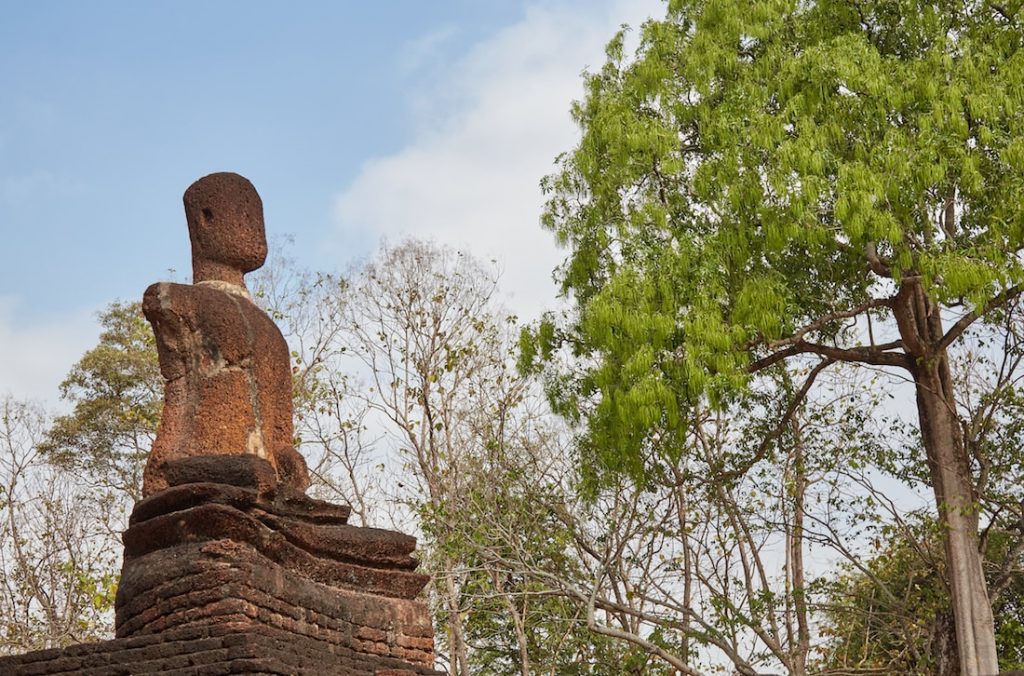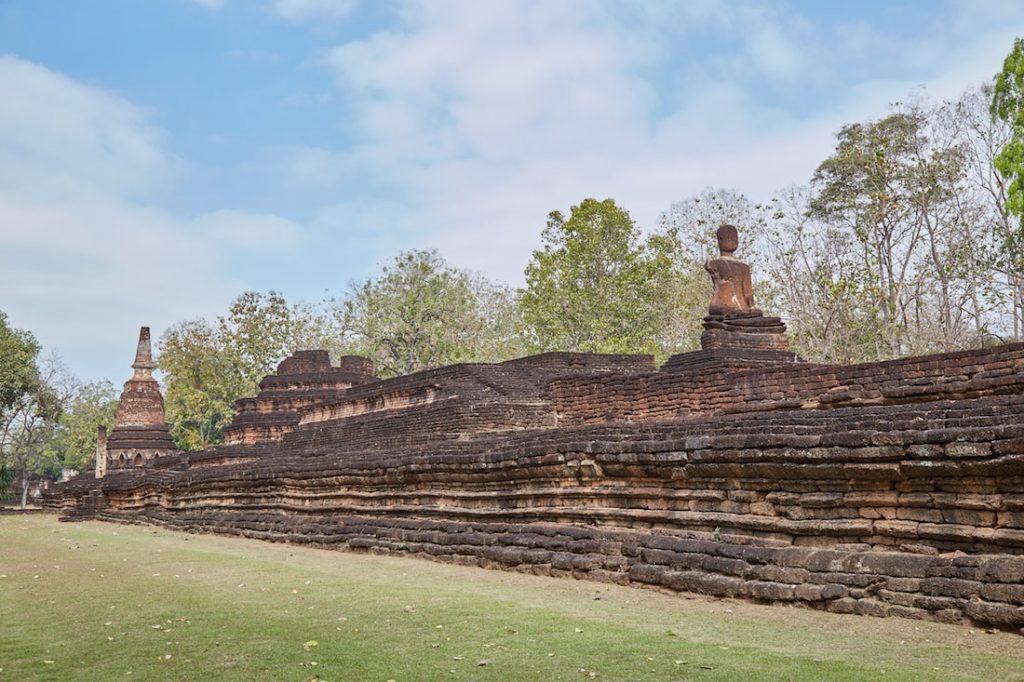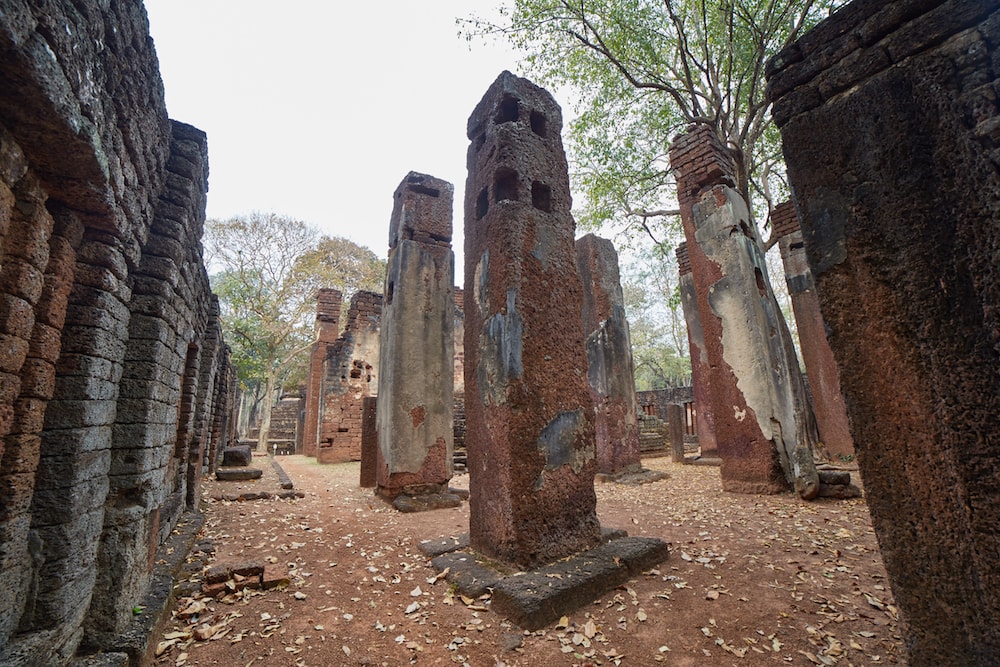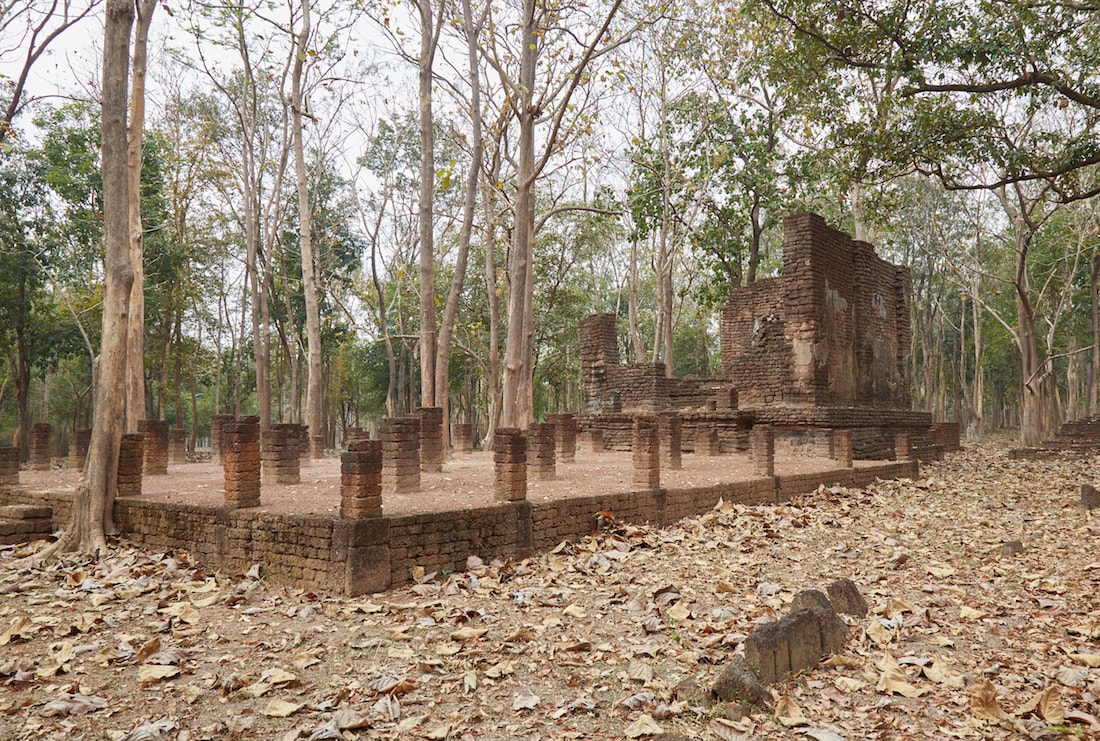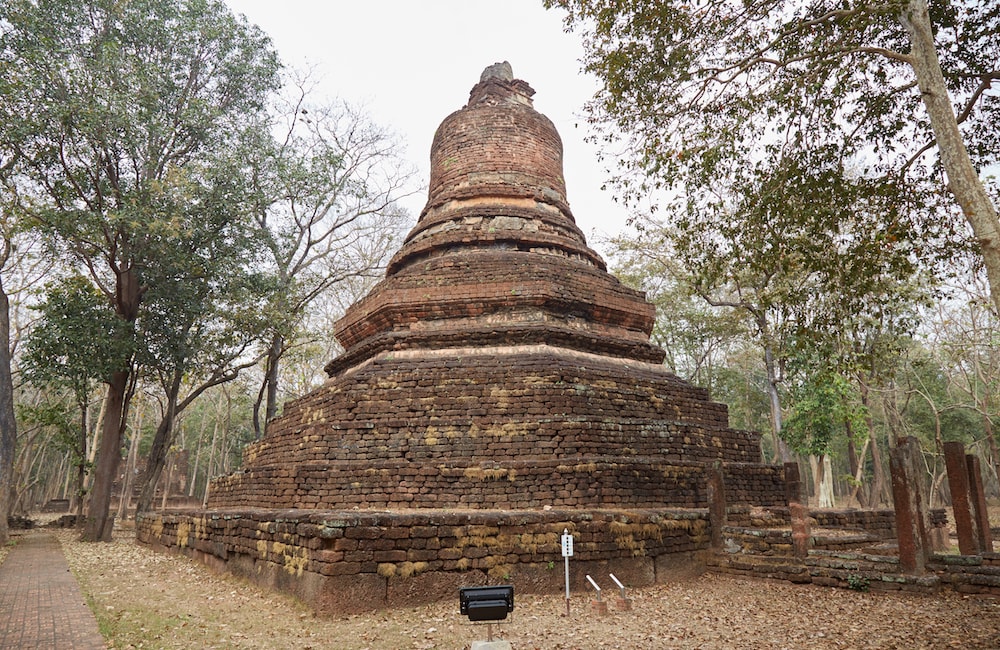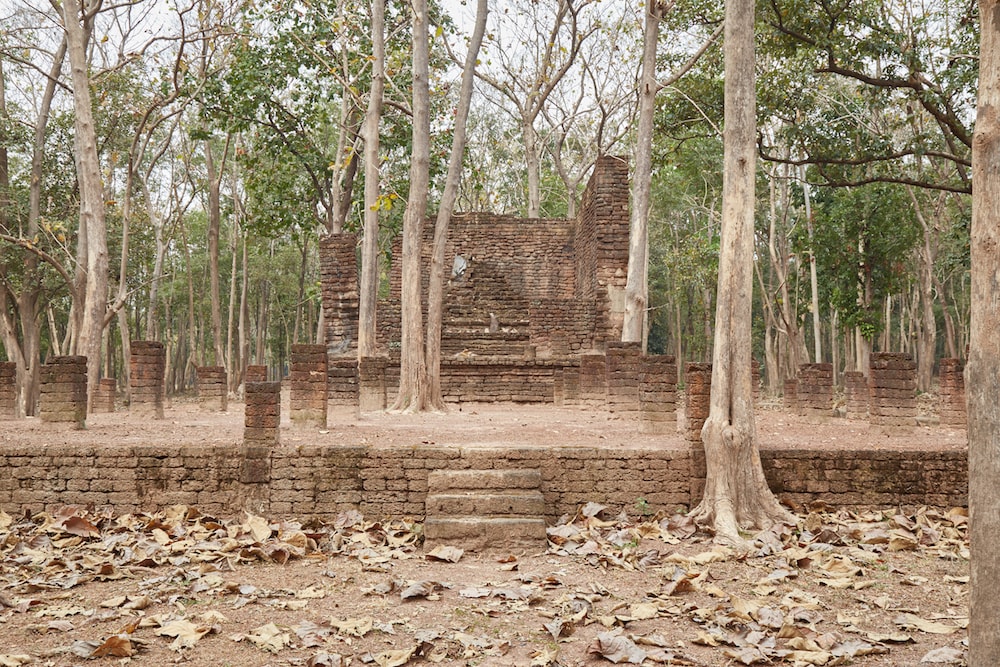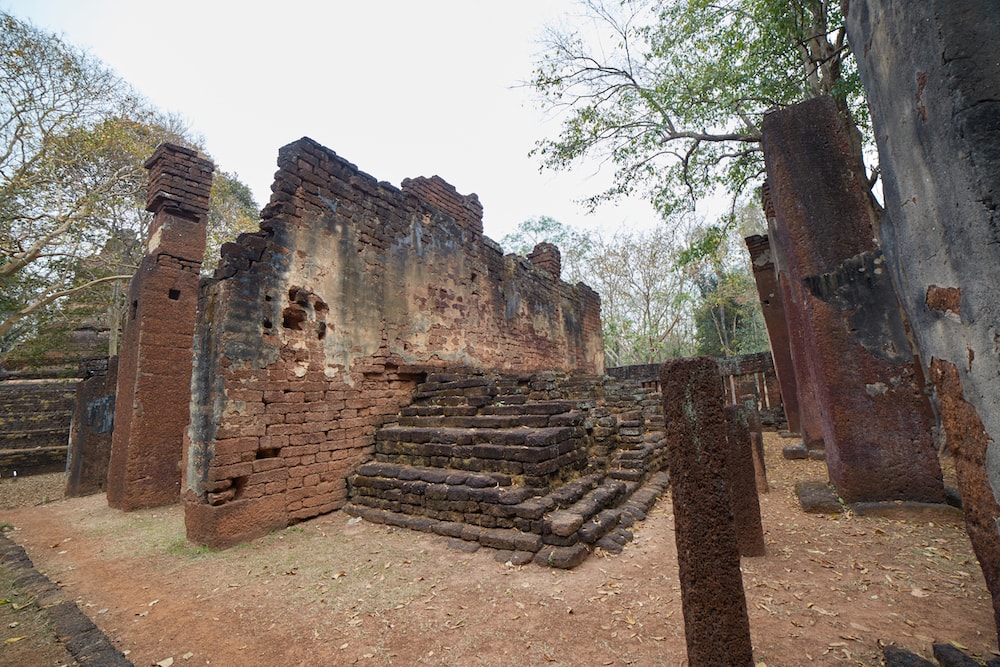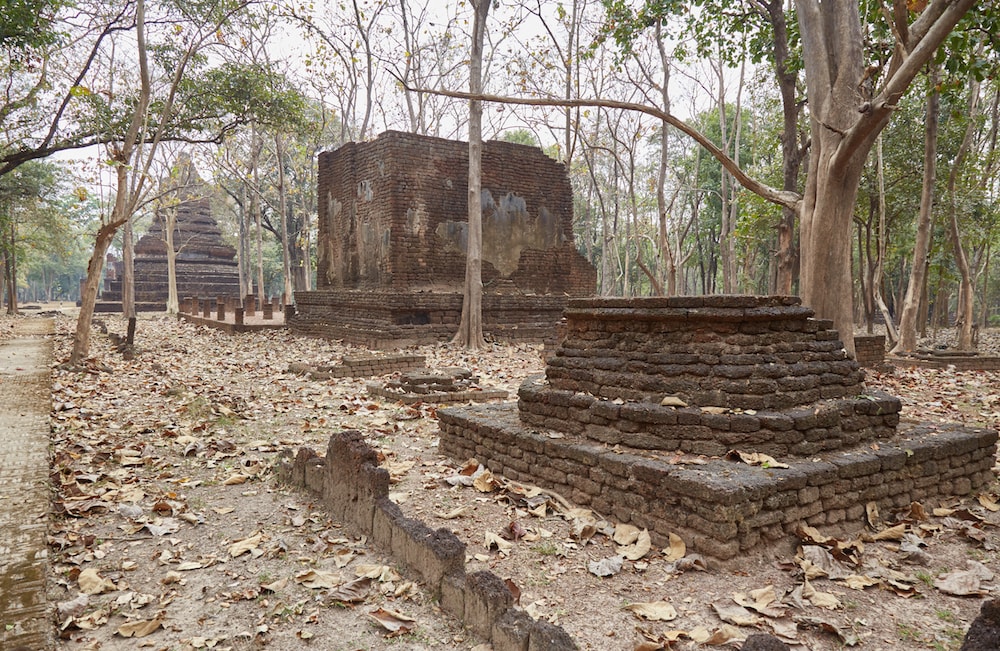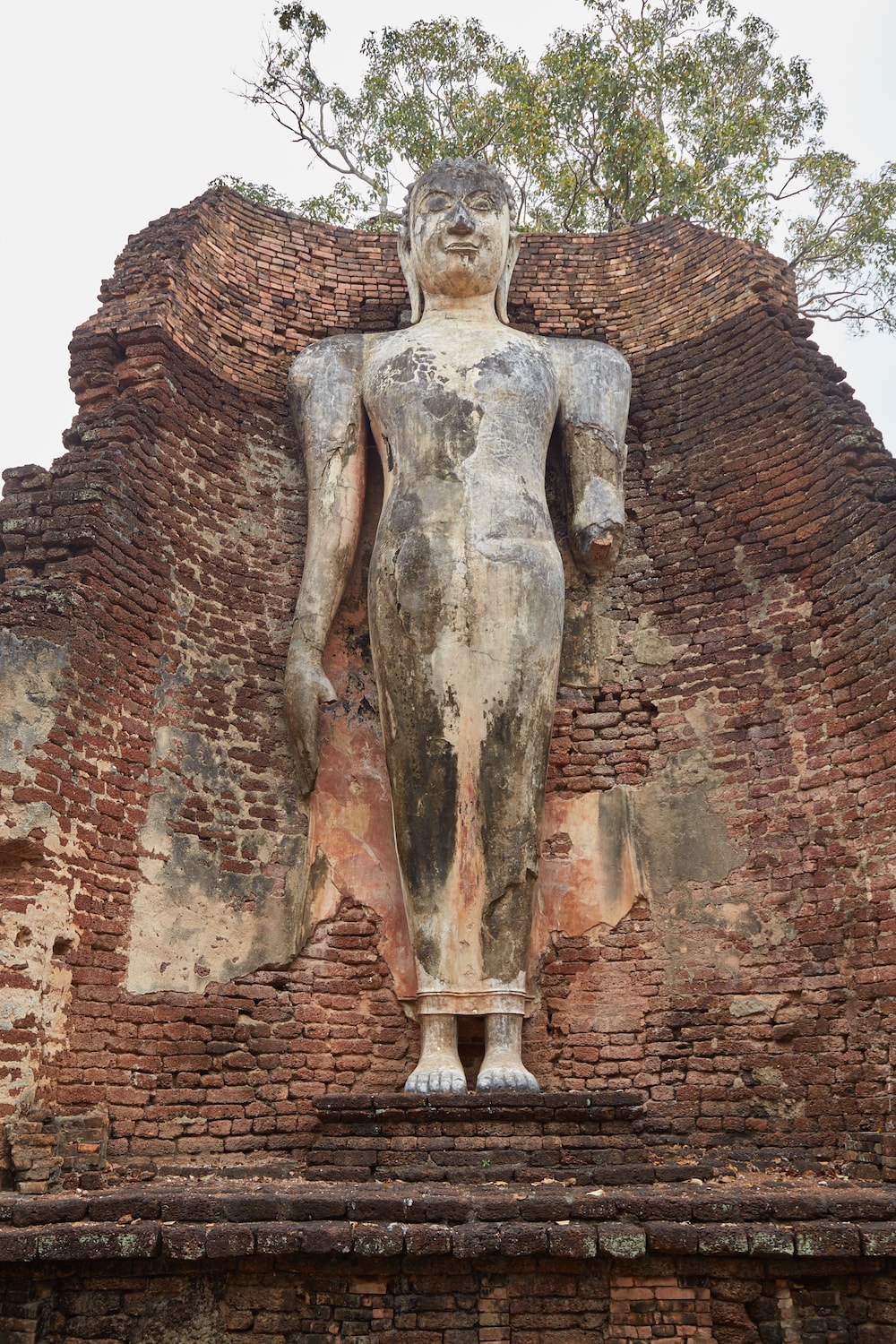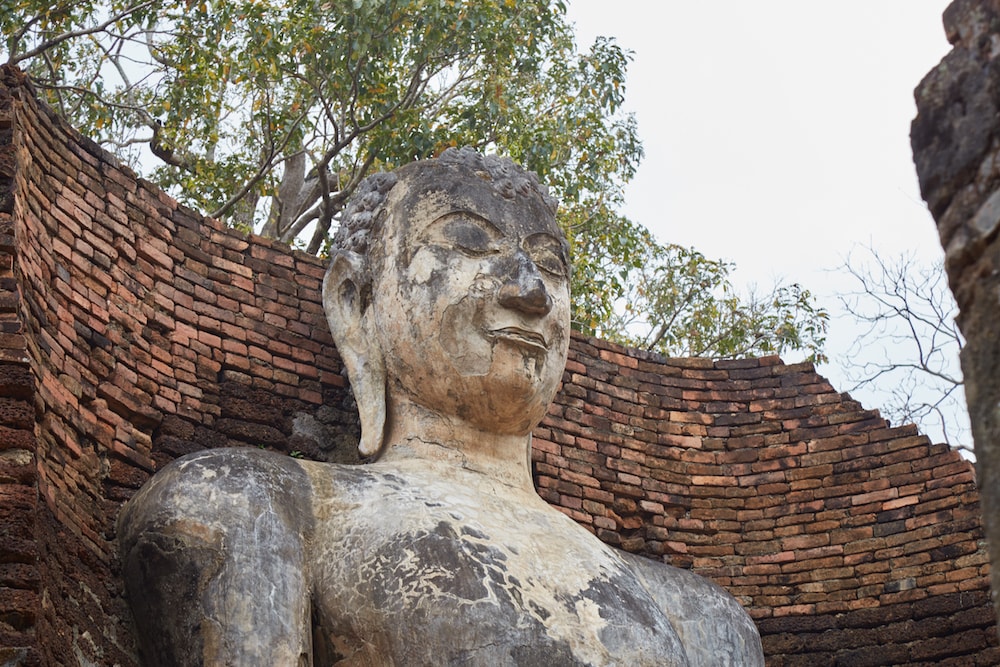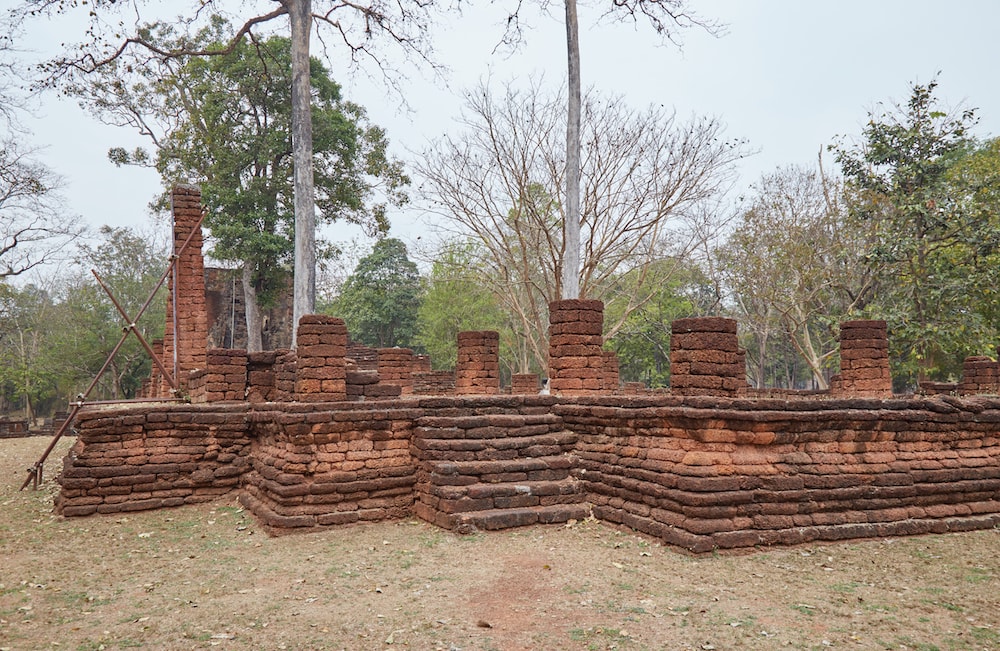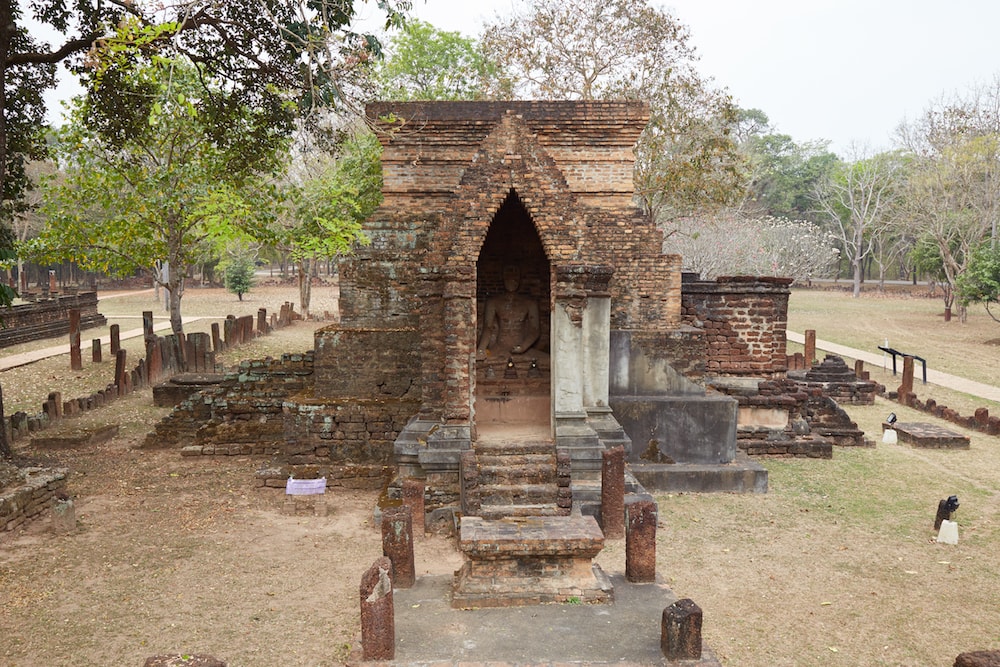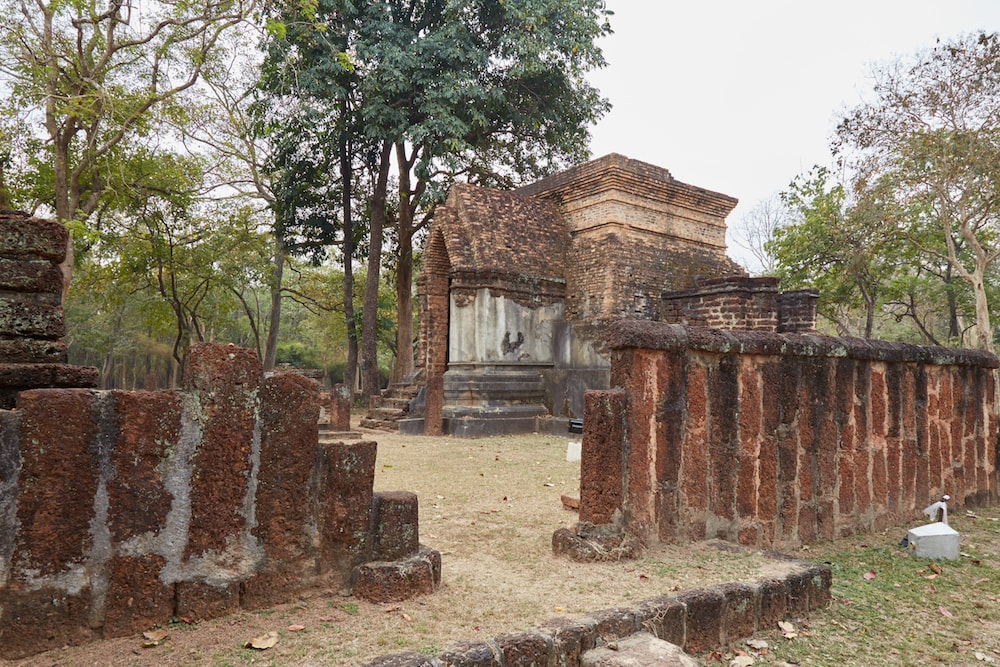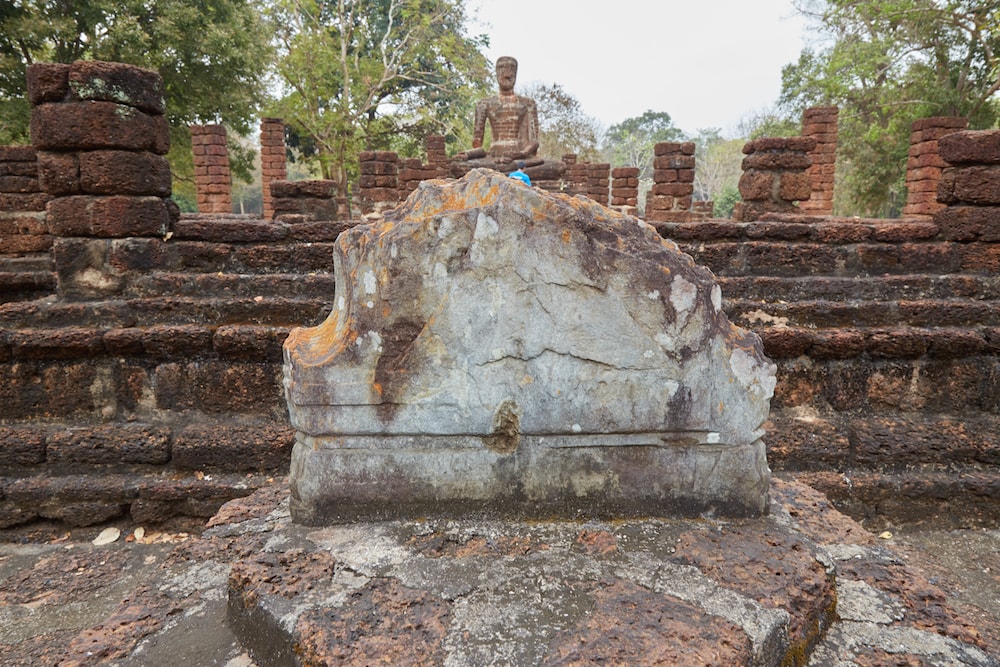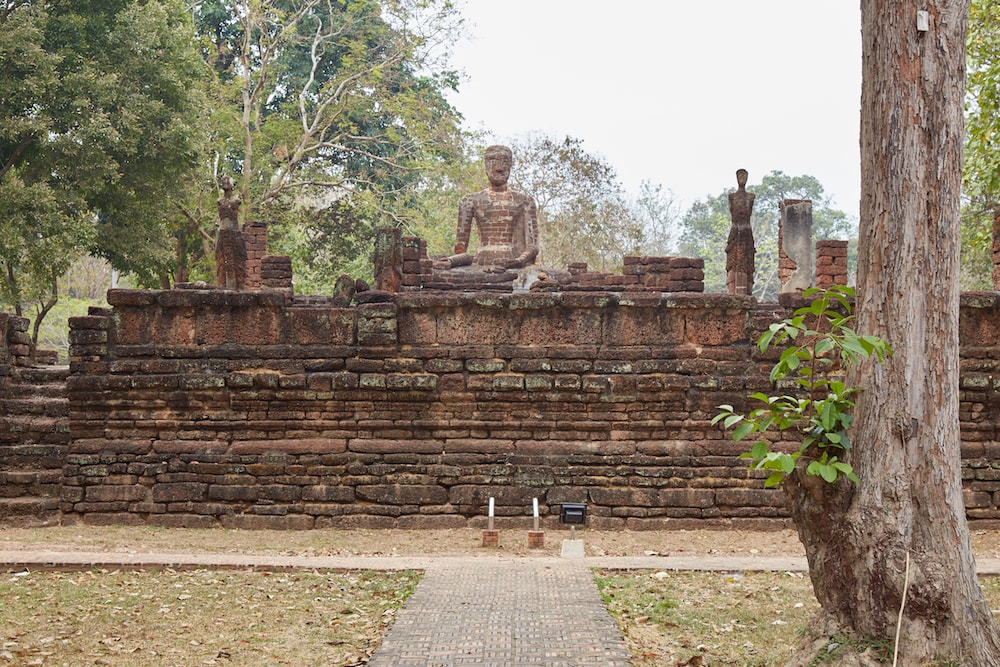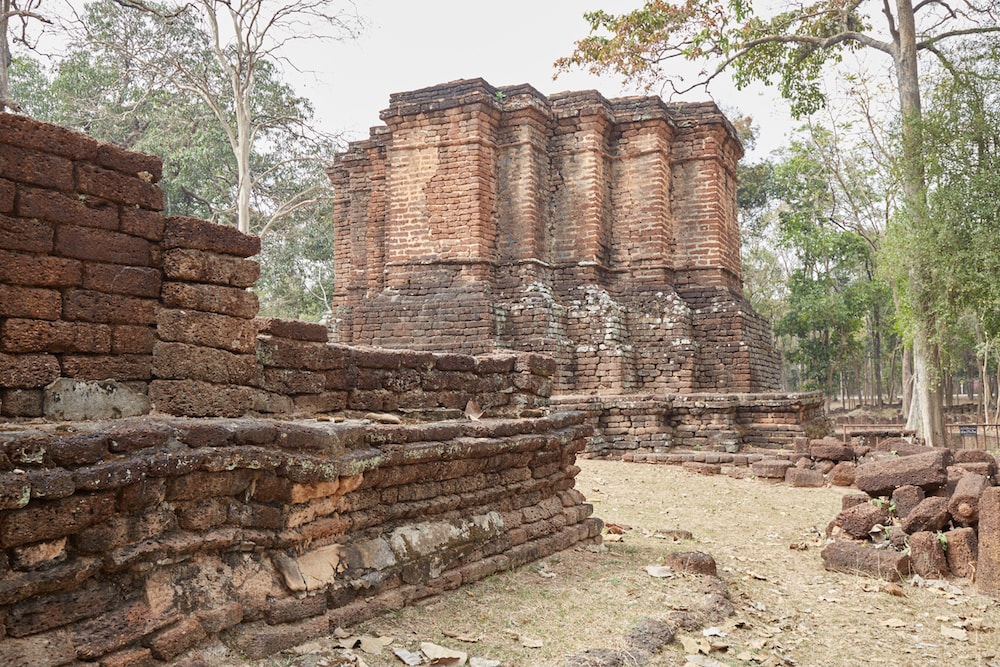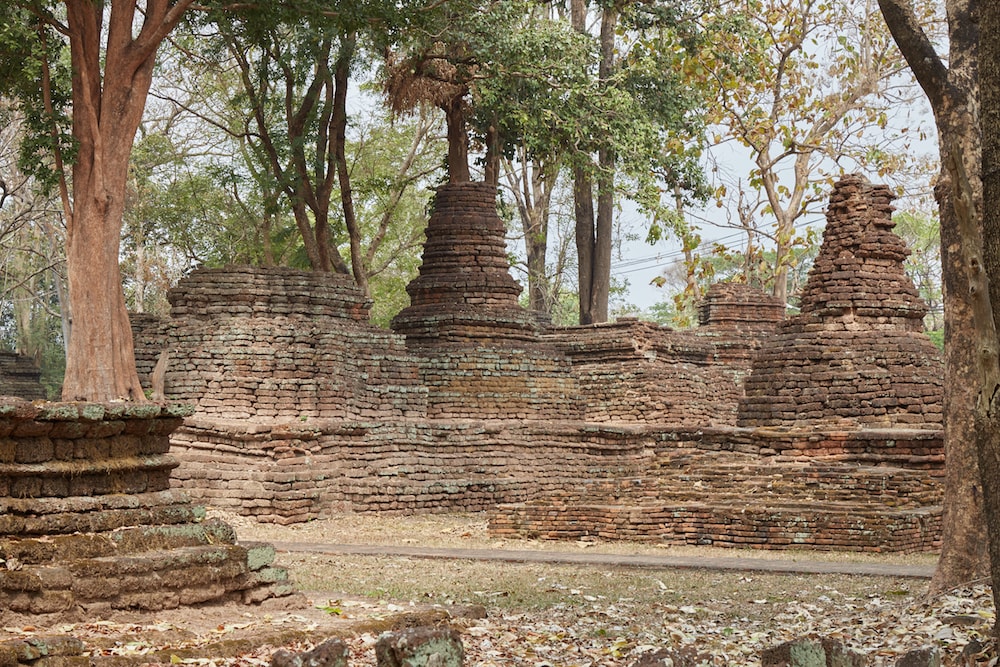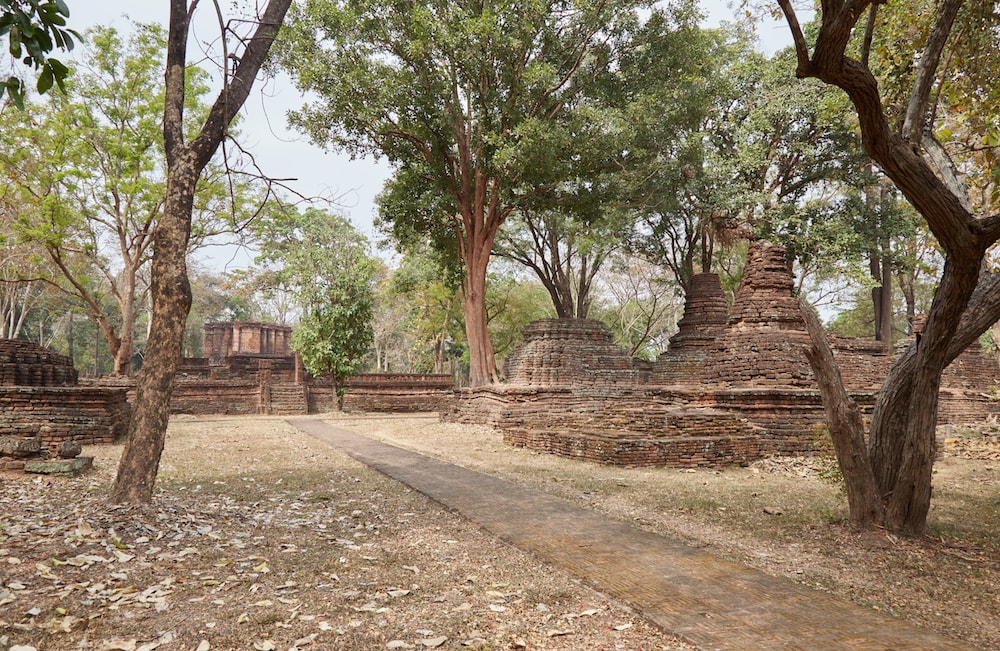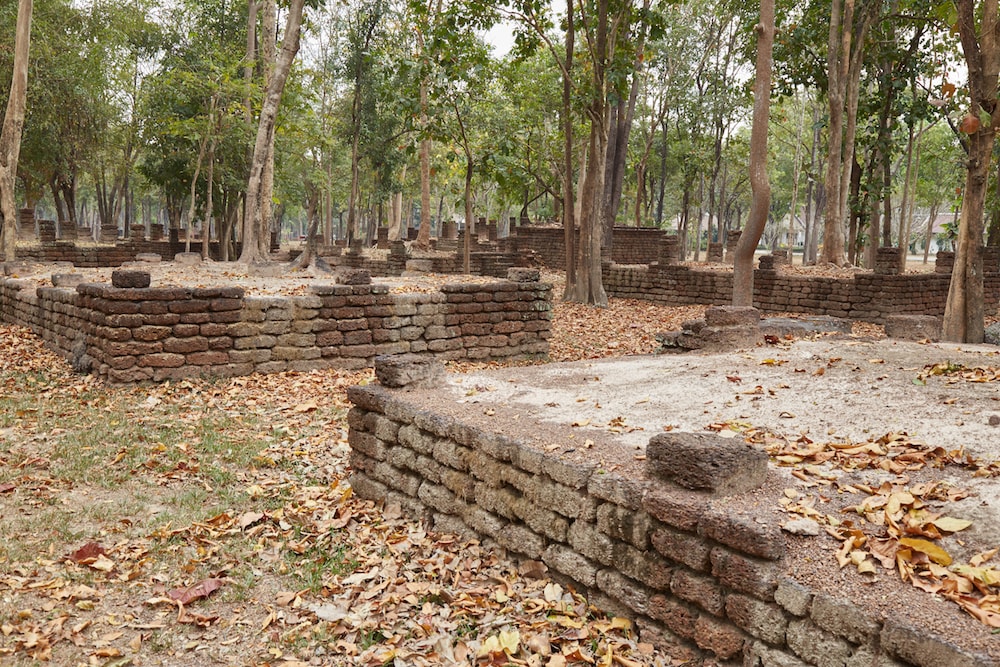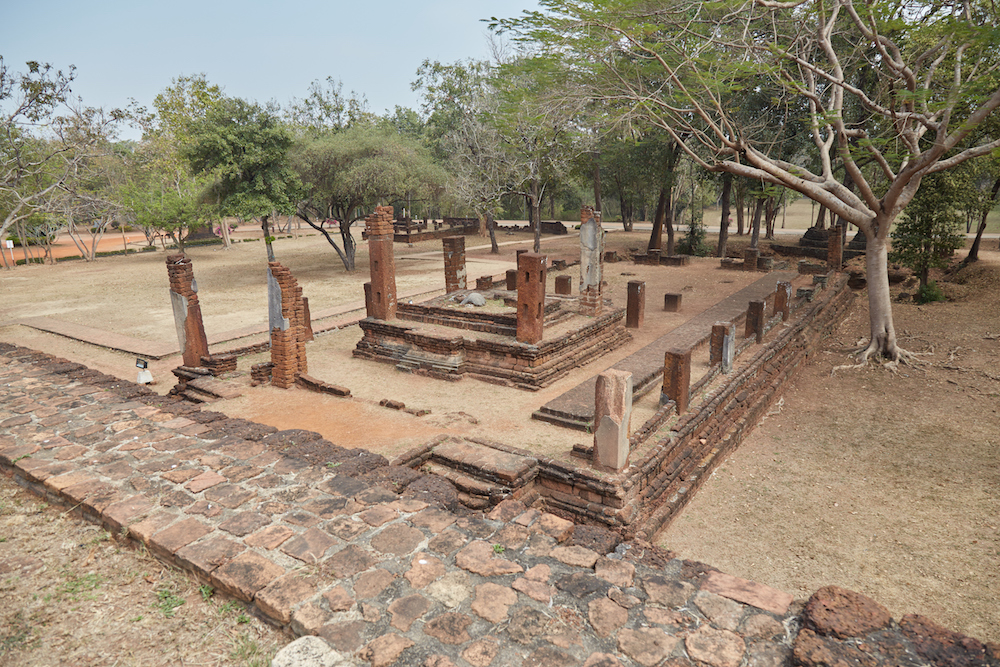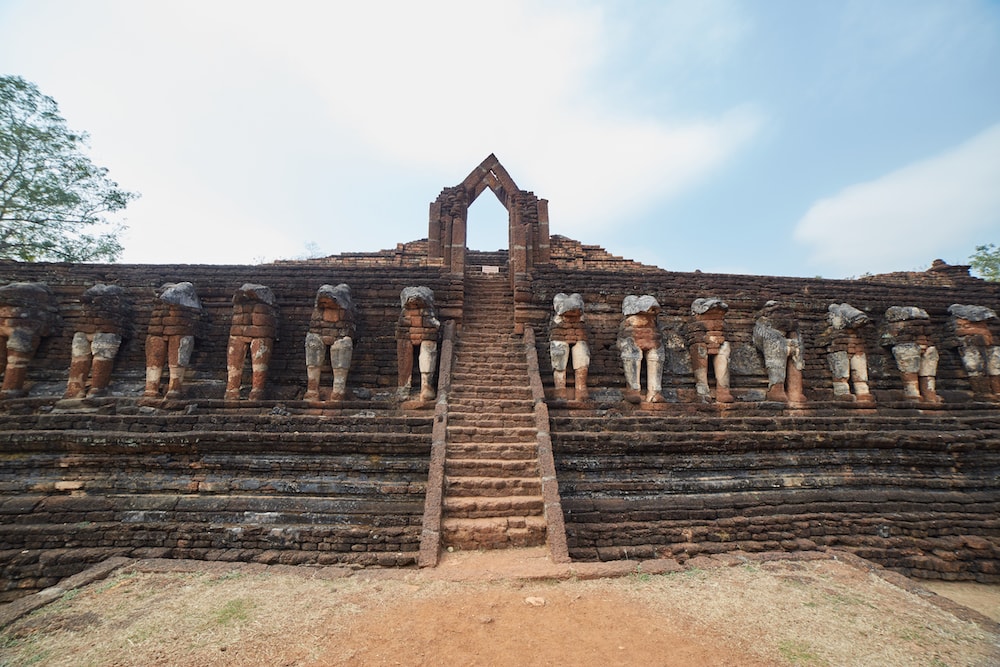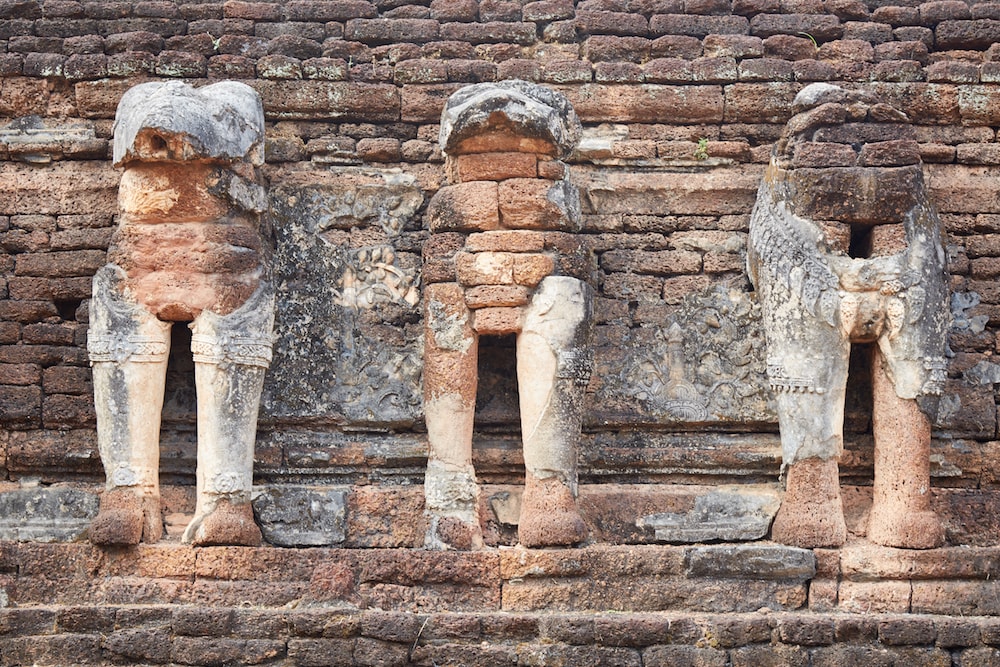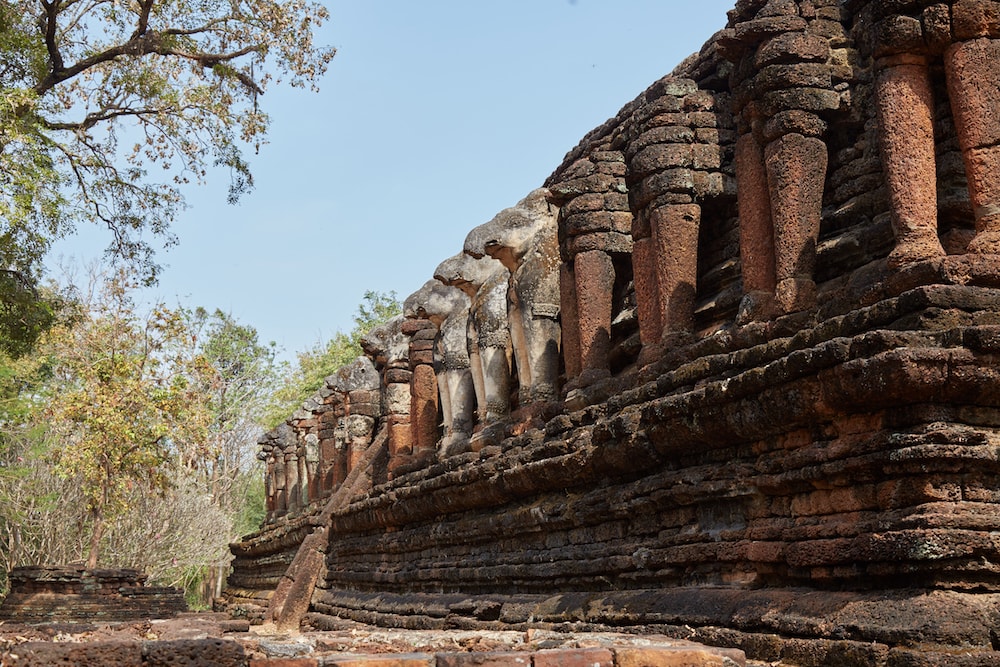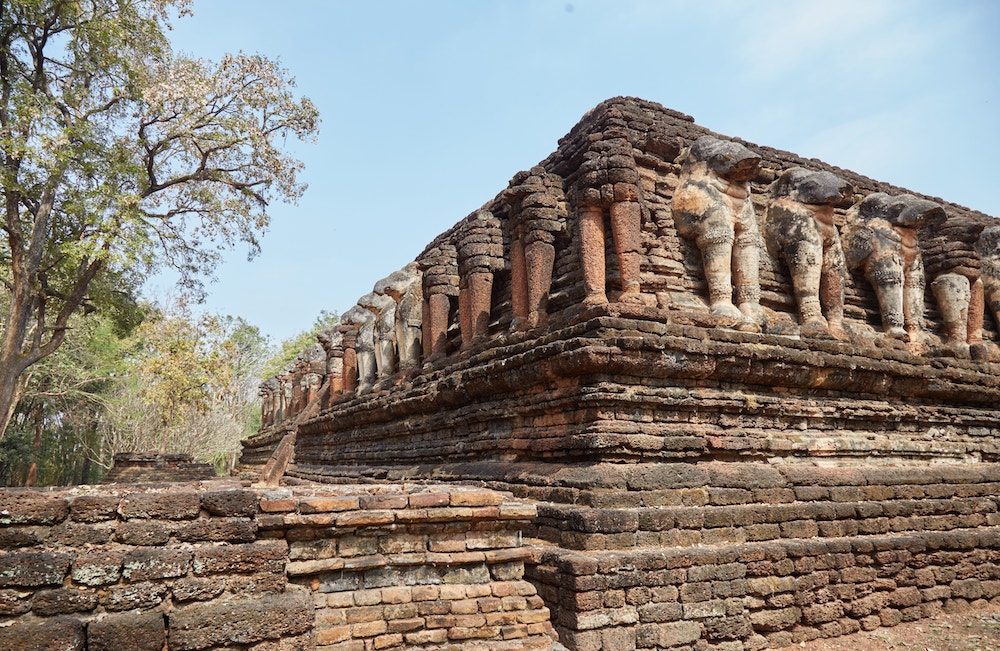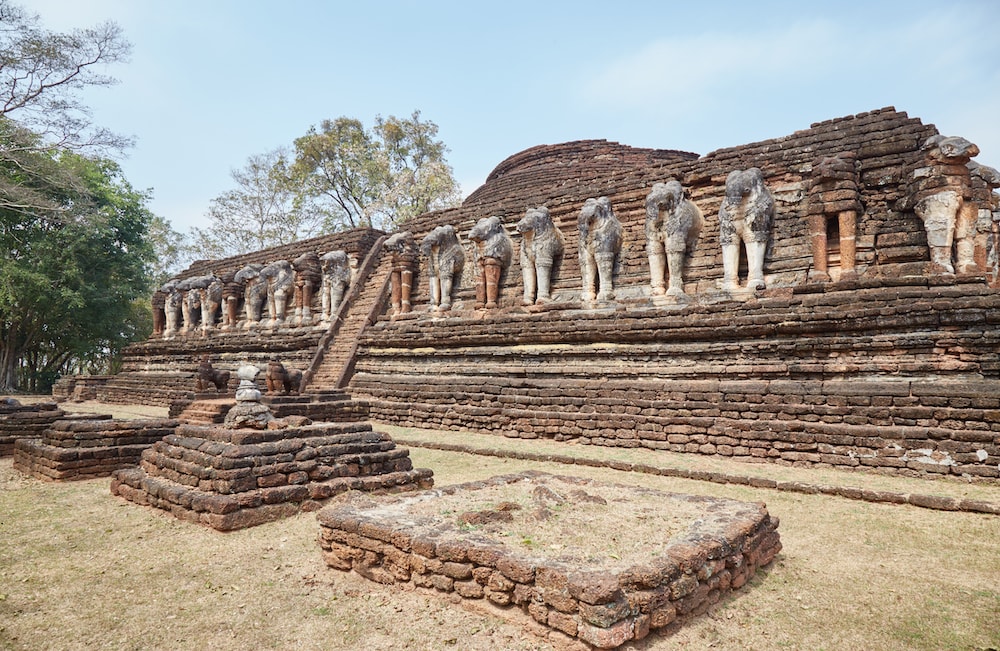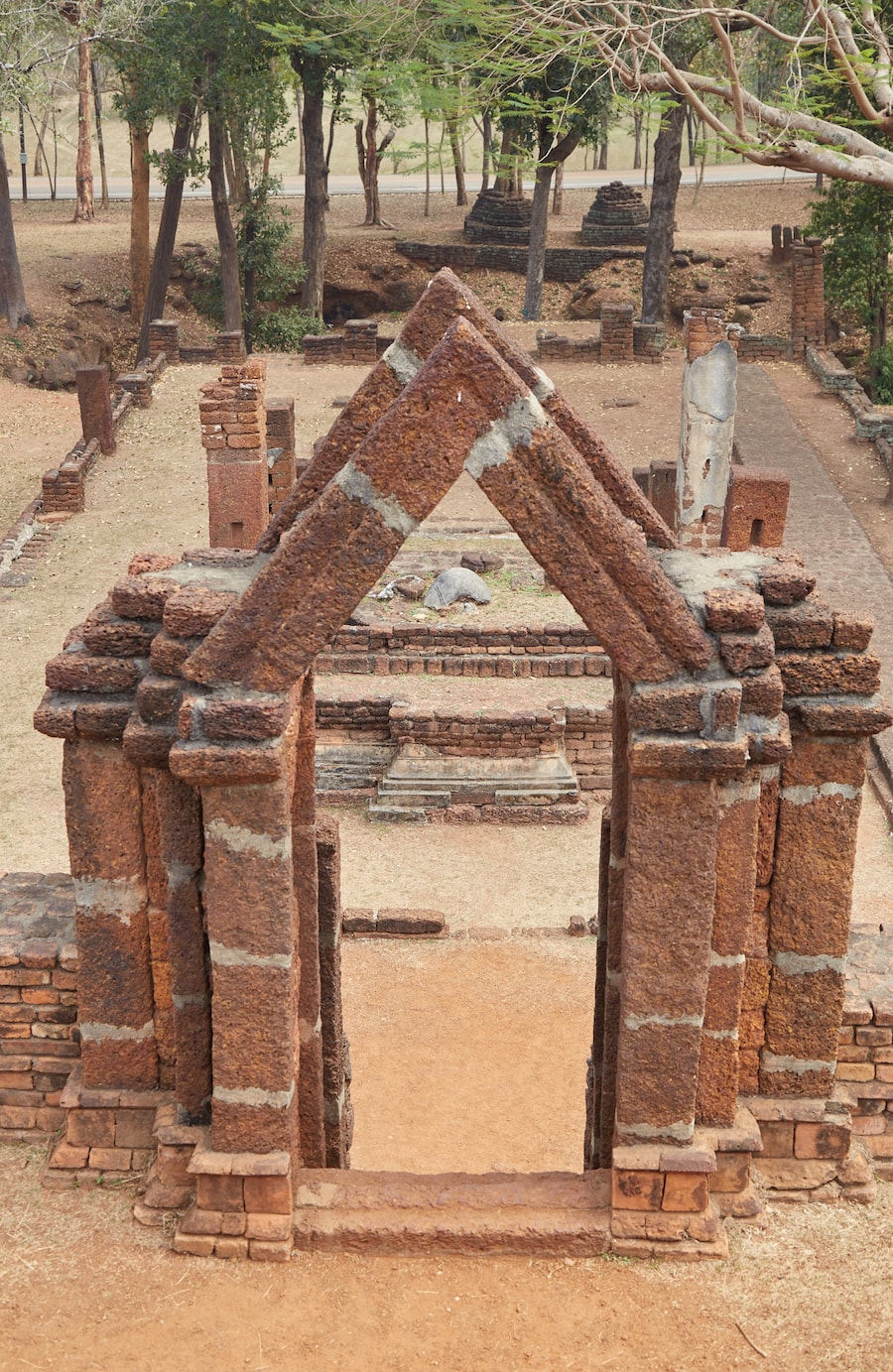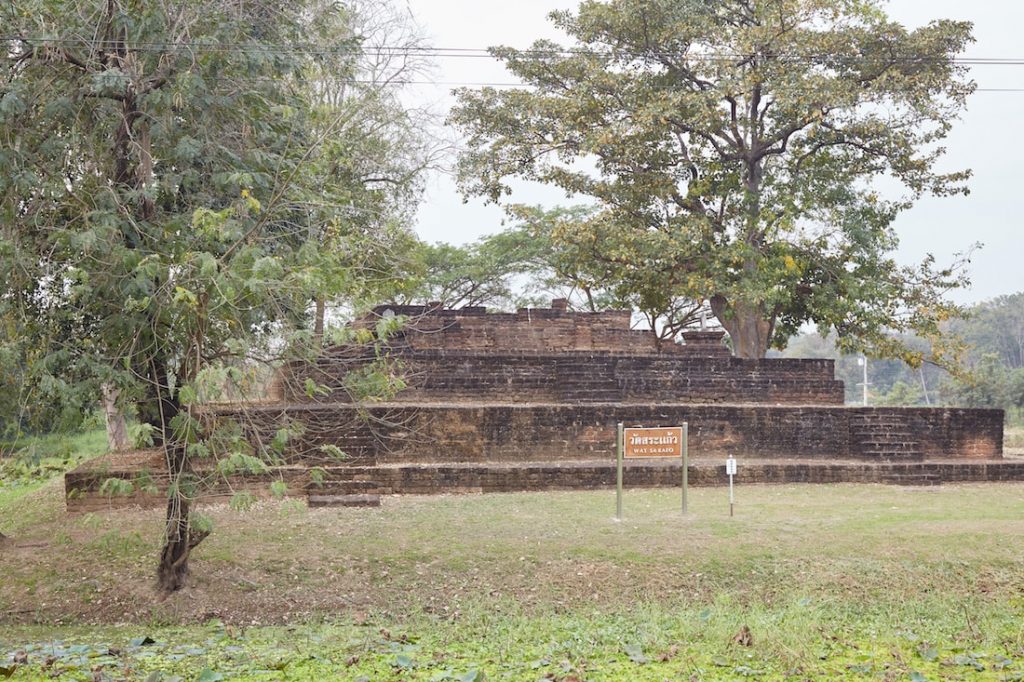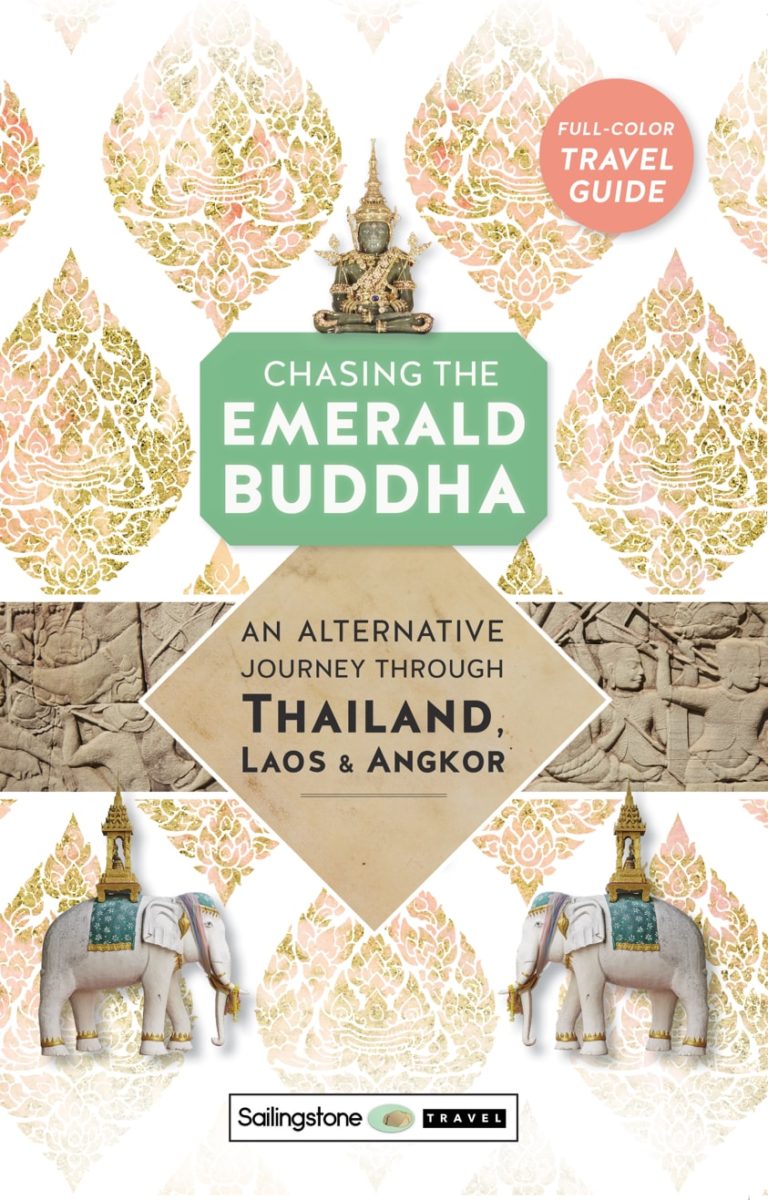Last Updated on: 27th January 2020, 11:35 am
The UNESCO World Heritage Site of Kamphaeng Phet has just about everything you’re looking for when it comes to old ruins. Extravagant ancient temples, fascinating history and a picturesque setting. But one thing it lacks, to the pleasant surprise of those who visit, are other tourists. Learn why this former outpost town dubbed the “Diamond Wall” is one of Thailand’s most overlooked and underrated archaeological sites.
Kamphaeng Phet: A Brief History
Kamphaeng Phet prospered for centuries in large part due to its strategic location along the Ping River. It was first used as an outpost of the Khmer Empire from the 12th century, marking the western edge of their mighty kingdom.
After the Sukhothai Kingdom gained independence from the Khmer, they continued to use Kamphaeng Phet to defend themselves from powerful Burma to the west. Around this time, the city also became an important cultural and religious center in addition to a defensive one, with new large temples being built in the same manner as the capital.
But from the 15th century, the rising power of Ayutthaya overtook Sukhothai, absorbing Kamphaeng Phet into its territory. During this era, the Ayutthaya rulers continued developing Kamphaeng Phet while mostly allowing the once-glorious Sukhothai to decay. Even stronger defensive walls were fortified, thus giving the city its current moniker which translates to “Diamond Wall.”
Ayutthaya built even more temples, including many outside the city walls. The Thai Forest tradition of Buddhism flourished at this time. Kamphaeng Phet became such an important religious center that even the palladium of Thailand, the Emerald Buddha statue, was kept here before its emergence in Chiang Rai.
But after hundreds of years of prosperity, the good times would eventually come to an end. In the 1500’s, the Burmese finally broke through the city’s defenses. Though they wouldn’t entirely conquer Ayutthaya until the late 18th century, Kamphaeng Phet was mostly left deserted from the 16th century onward.
And today, the city has largely been left deserted by tourists as well. Despite its convenient location in between Chiang Mai and Bangkok, and the fact that it was declared a UNESCO World Heritage site in 1991, you’ll likely find yourself roaming the ancient ruins alone.
That, of course, is a large part of the town’s appeal. For those looking for spectacular ruins that are off-the-beaten-path, you can’t do better than Kamphaeng Phet. Considering how close it is to Sukhothai, it’s also easy to combine the two archaeological sites into a single trip.

Kamphaeng Phet is divided into the Central and Forest zones. The map above contains everything featured in the article below. However, the lesser significant forest ruins have been marked in yellow to avoid confusion if you’re just visiting the highlights.
The Central Ruins
The Central Ruins were in the middle of the ancient walls of old Kamphaeng Phet, and they’re still right in the middle of the modern-day version of the city. Also featured in this section are places like the museum and Shiva Shrine, which are technically outside the archaeological zone but still very close to the central ruins themselves.
Wat Phra That
Entering the area, you won’t be able to miss the large bell-shaped chedi of Wat Phra That, dating back to the 15th century. This temple was situated just next to the old royal palace, of which nothing remains today.
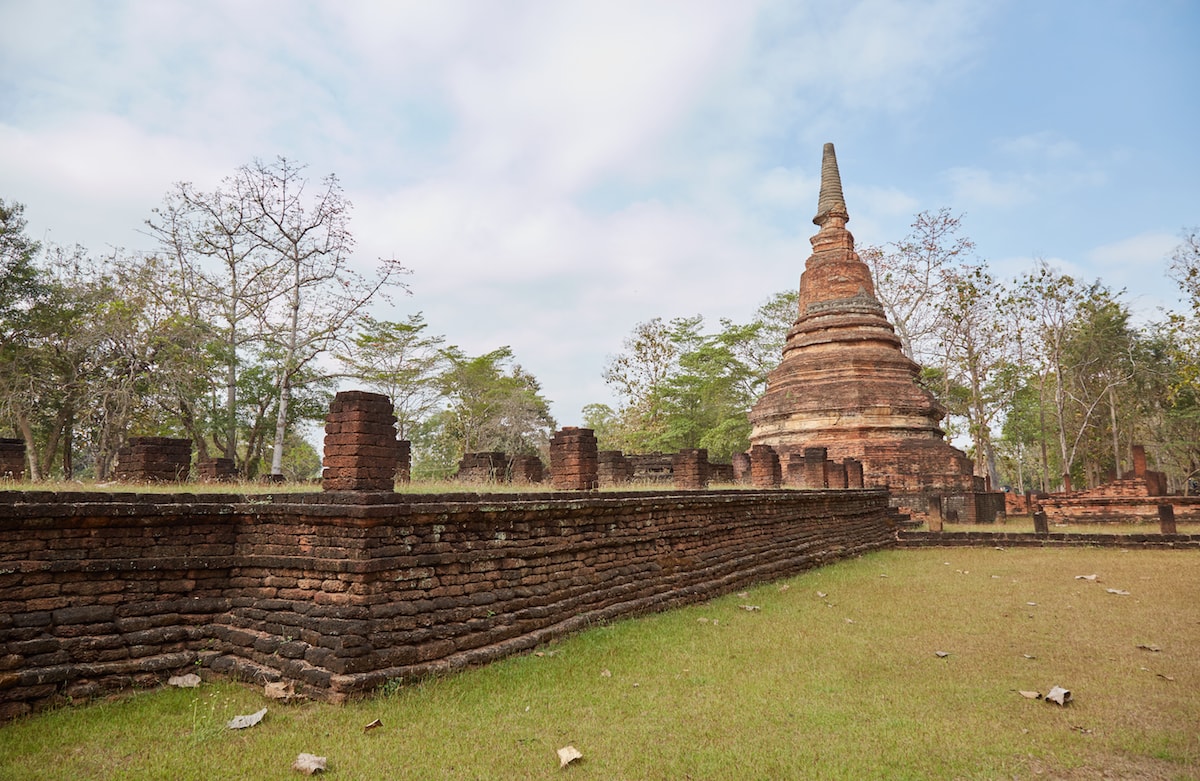
Conveniently, many signs have been placed around the ruins showing what certain temples would’ve looked like before falling into a state of decay. In Wat Phra That’s case, it had a long rectangular viharn which started in between the two smaller chedis at the eastern end.
The viharn led to a single massive chedi, around which was a rectangular open-aired gallery for Buddha statues and other artwork. While common in temples today, this was somewhat of a rare feature for Kamphaeng Phet at the time.



Wat Phra Kaew
Wat Phra Kaew was the largest temple in Kamphaeng Phet, and it’s also an important temple in Thai history overall. If the name sounds familiar to you, that’s because it shares a name with Wat Phra Kaew in Bangkok’s Grand Palace complex, the current home of the Emerald Buddha.
During the statue’s many travels over the years, it also resided at this very temple in Kamphaeng Phet, which was the last place it was kept before its disappearance and rediscovery within a broken chedi in Chiang Rai.
But that’s not all. Wat Phra Kaew was also host to the golden Phra Sihing Buddha statue, the second most important Buddha image in Thailand. While the two statues would reside in the same town on a number of occasions throughout their intertwined histories, Wat Phra Kaew may possibly be the only case where both were kept together at the same temple.


Wat Phra Kaew is much larger in size than Wat Phra That, but shares a similar narrow rectangular shape. There used to be a long viharn, the base of which still contains an old laterite Buddha image. At the end of the platform is a mysterious structure with a small staircase leading up to its base.
Considering how this would’ve been indoors, and also taking into account the size of the opening at the top, it’s now believed that this was a special altar designed to hold the Emerald Buddha.

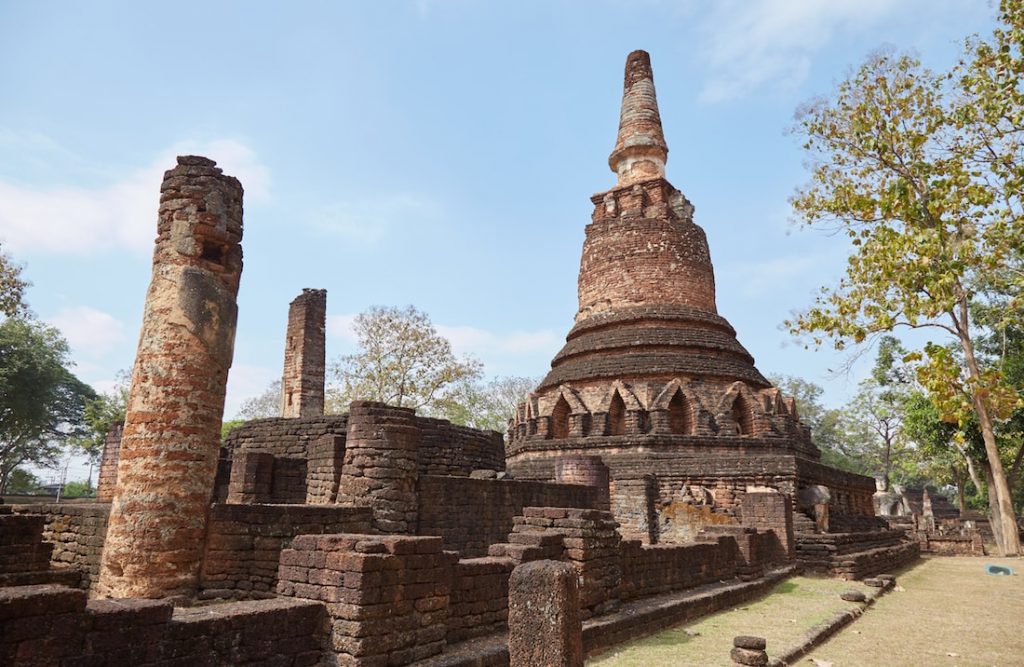
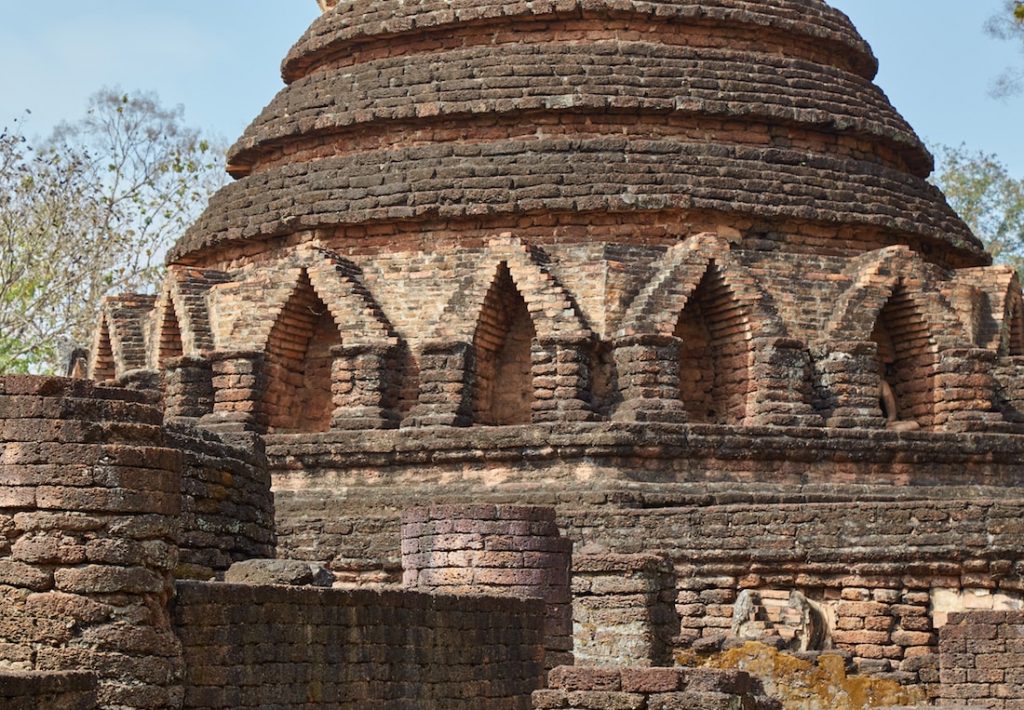
Past the viharn is the main chedi, still in good shape today. You can still see some small Buddha images remaining in the 16 niches around the center. The base also once featured 32 lion sculptures, though most of those are now missing.
Past the chedi was another monastery built to hold the massive reclining Buddha image. The image, along with two large seated Buddhas behind it, remain among the best-preserved parts of the temple. The Buddhas were constructed with brick which was then covered in stucco.
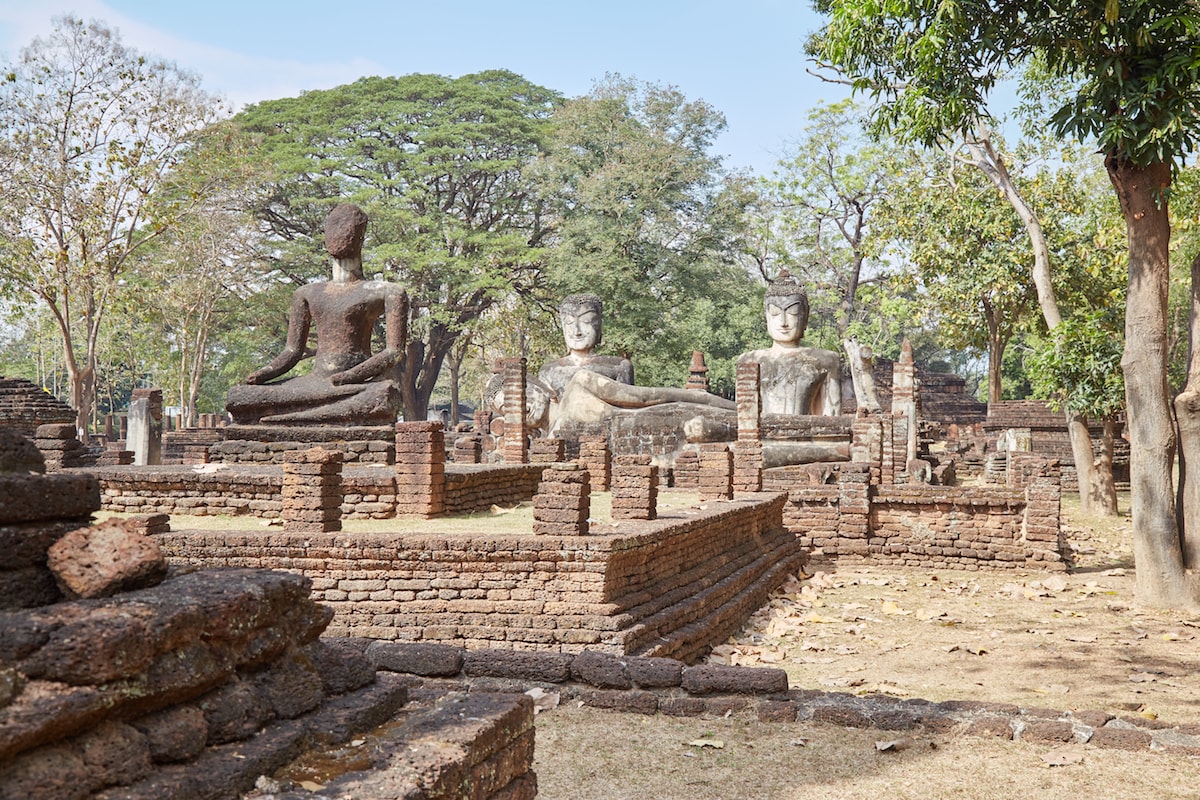
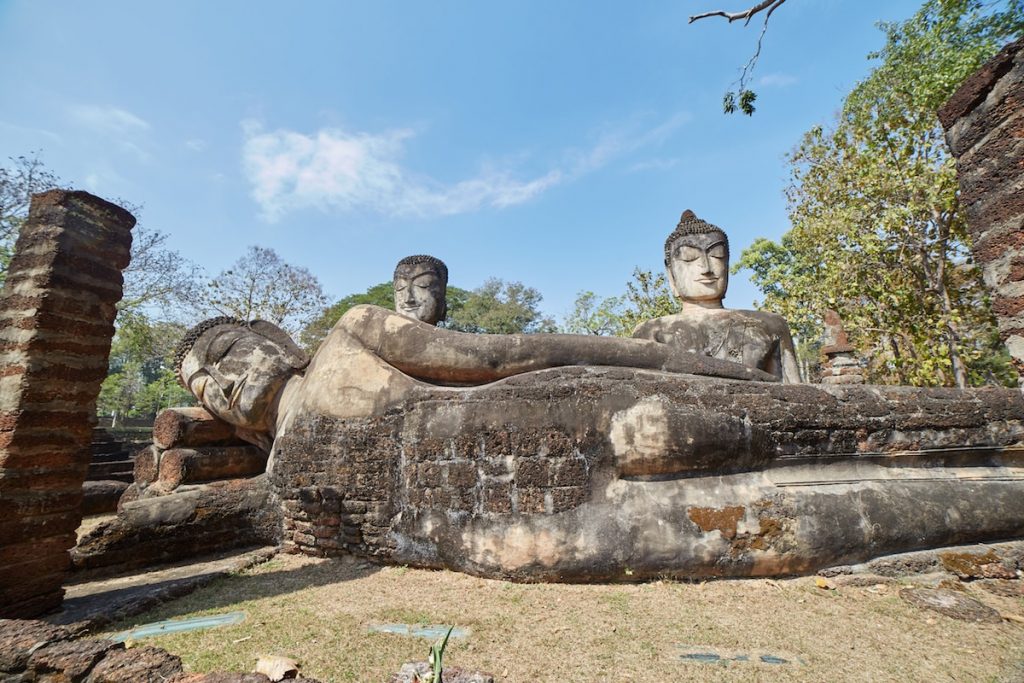
Looking closely, you can see remnants of gold leaf on the reclining Buddha’s face, providing a clearer picture of how these gigantic statues would’ve looked in their prime. Regarding the statues’ artistic style, there’s still debate over whether the images represent Sukhothai or Ayutthaya art. Though some suggest them being the result of a unique Kamphaeng Phet style.
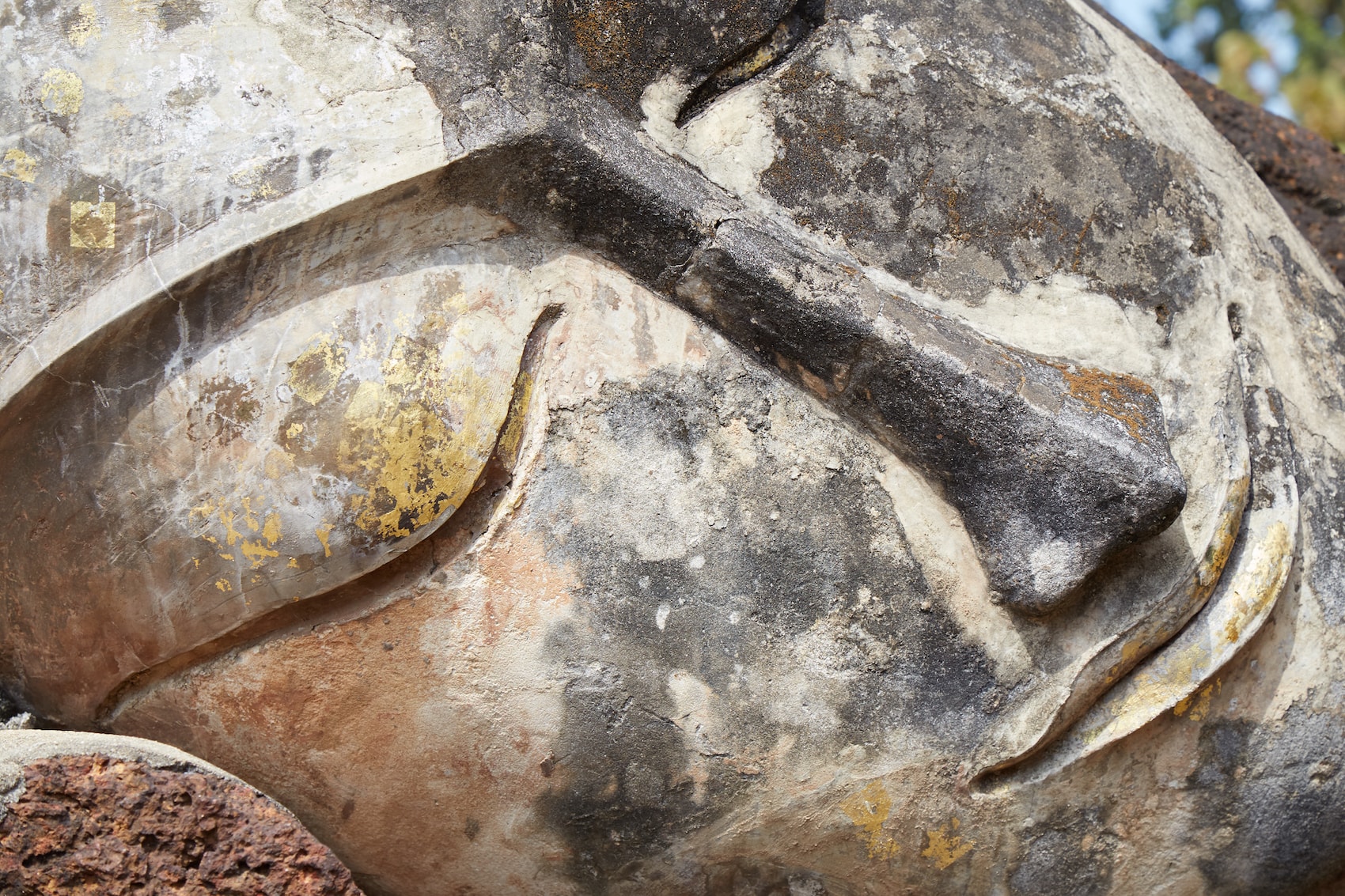
Walking around the compound, you’ll find the base of another large chedi, now collapsed, which once had a total of 32 elephants encircled around it, characteristic of Sukhothai temple architecture. You’ll also see plenty more laterite Buddhas and the bases of other smaller chedis. Additionally, archaeologists believe there were a number of other smaller wooden viharns and mondops in the back.
While it may not look it today, Wat Phra Kaew surely would’ve been one of the most prominent and politically important temples in all of Siam back in its day – perhaps rivaled only by Wat Phra Si Sanphet in Ayutthaya.
The City Pillar
Just outside of the western side of the archaeological zone is the Kamphaeng Phet city pillar. In fact, there are two of them – the new one and the original. In Thailand, City Pillars are venerated in order to protect a city and its inhabitants. Rather than being a Buddhist tradition, the concept is rooted in Hindu and animist beliefs.
Kamphaeng Phet’s original city pillar is said to go back 700 years to the Sukhothai era, with the new one having been installed as recently as 2007.
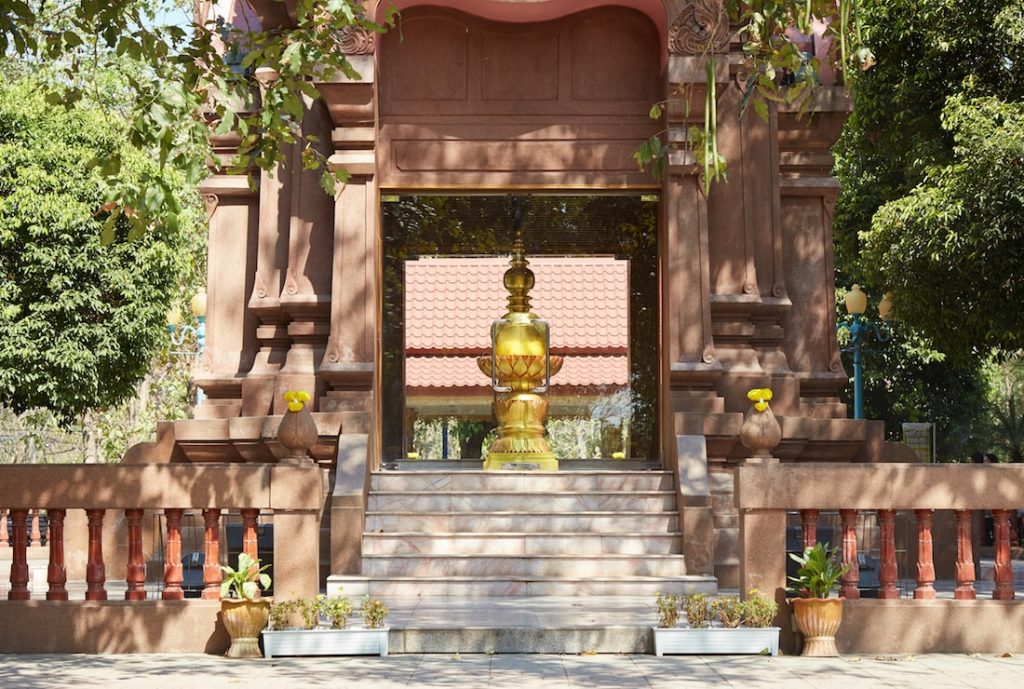
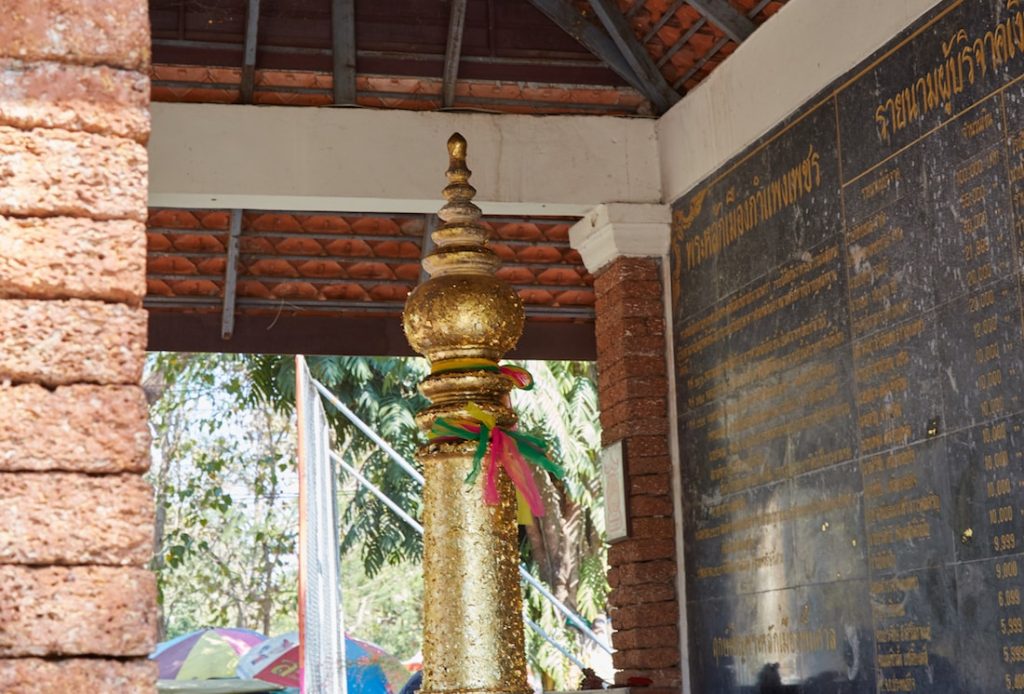
Shiva Shrine
One of the more unique attractions in Kamphaeng Phet is its Shiva shrine. While the area had been exposed to Hinduism during its days as a Khmer outpost (and probably as a Dvaravati town before that), the statue is as recent as 1510 AD. This means it was constructed during the Ayutthaya days, long after Theravada Buddhism had established itself as the dominant religion – and even after many of the city’s temples had been built.



An inscription reads that the shrine was built to protect all two-legged and four-legged creatures in Kamphaeng Phet, meaning lots of people come here to pray for their pets!
Another interesting bit of trivia is that the head and arms of the statue were stolen by a German visitor in the 1800’s. A replica was built, which is what you see in the shrine now. After the Thais successfully got the missing parts back, the original statue was placed in the nearby National Museum. Supposedly, you can even find another replica in Germany’s Berlin Museum!
Kamphaeng Phet National Museum
Just next to the city ruins is the Kamphaeng Phet National Museum, which is easily one of the best of its kind in Thailand. Inside you’ll find artifacts from around the region’s many temples, not to mention the original Shiva statue. There are also informative English exhibits on the cultural influence left by both the Dvaravati and the Khmer.
Keep in mind that the museum costs an extra 100 baht to enter, and is not included in any of the tickets you can buy to enter the ruins. Though you’ll likely find yourself alone inside, this is an informative and well put together museum that’s worth exploring for an hour or two.

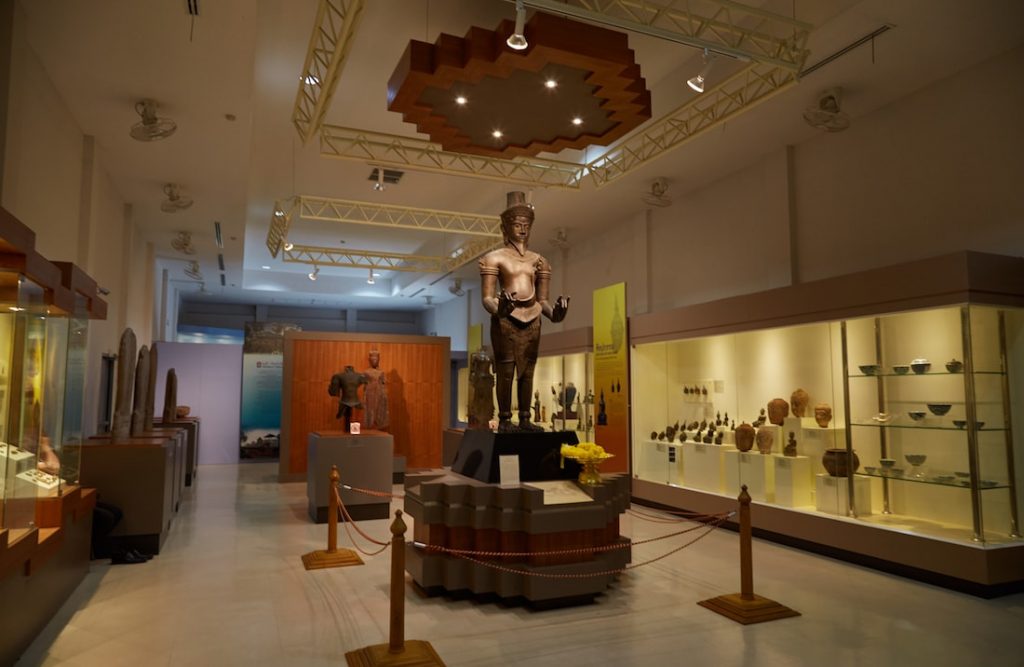
The Forest Ruins
In Thailand, there’s long been what’s known as the Buddhist ‘forest tradition.’ Rather than dwell in busy and distracting city centers, some monks choose to live out in the forest, much like the Buddha himself did. But touring the ancient forest temples, you’ll likely be surprised by the sheer number of them all. It seems more or less like there once existed a bustling city within the forest itself!
Below we’ll go over the five main highlights of the area, along with a list of the less essential ones. If you want to see everything and have a bicycle, you can probably do it in about 3 or 4 hours. Remember, this zone has its own ticket entry system that’s separate from the central zone. It costs either 100 baht or you can enter using a combined 150 baht ticket (valid for 1 day only).
*Note: Confusingly, if you’re coming from the city center, you’ll likely pass by a defunct ticket office before the river. There actually are a number of small ruins past here in addition to some old walls. However, the area you want to go, called the Aranyik area, is reached by passing the river and then turning left. Look out for the signs.
Wat Phra Non
Situated near the entrance to the park, the first major temple you’ll encounter in the forest zone is Wat Phra Non. Archaeologists aren’t sure of its exact age, but it’s estimated to be as old at the 15th century. The temple once contained many of the typical structures you’d expect to find at a Thai temple, such as an ubosot and living quarters for monks. Today, and probably in the past as well, its main feature is the viharn.

The viharn once contained a huge reclining Buddha image. While it hasn’t survived, we can imagine something similar to the one in Wat Phra Kaew. What does remain are the viharn’s twelve towering laterite pillars, each of which is estimated to weigh around 30 tons.
Walking past the viharn, you’ll come across a large chedi and the remnants of a brick seated Buddha image, in addition to the brick bases of the other former structures. Clearly, Wat Phra Non was once an elaborate temple complex back in its day.
Wat Phra Si Ariyabot
Fairly close by to Wat Phra Non is Wat Phra Si Ariyabot, dated to sometime between the 14th and 16th centuries. Today, the temple is famous for its well-preserved 9-meter high standing Buddha statue, once contained inside of a mondop. Walking around the platform, you’ll see outlines of other gigantic Buddha poses, including sitting, reclining and walking. The name of this temple, in fact, translates to the “four postures of the Buddha.”
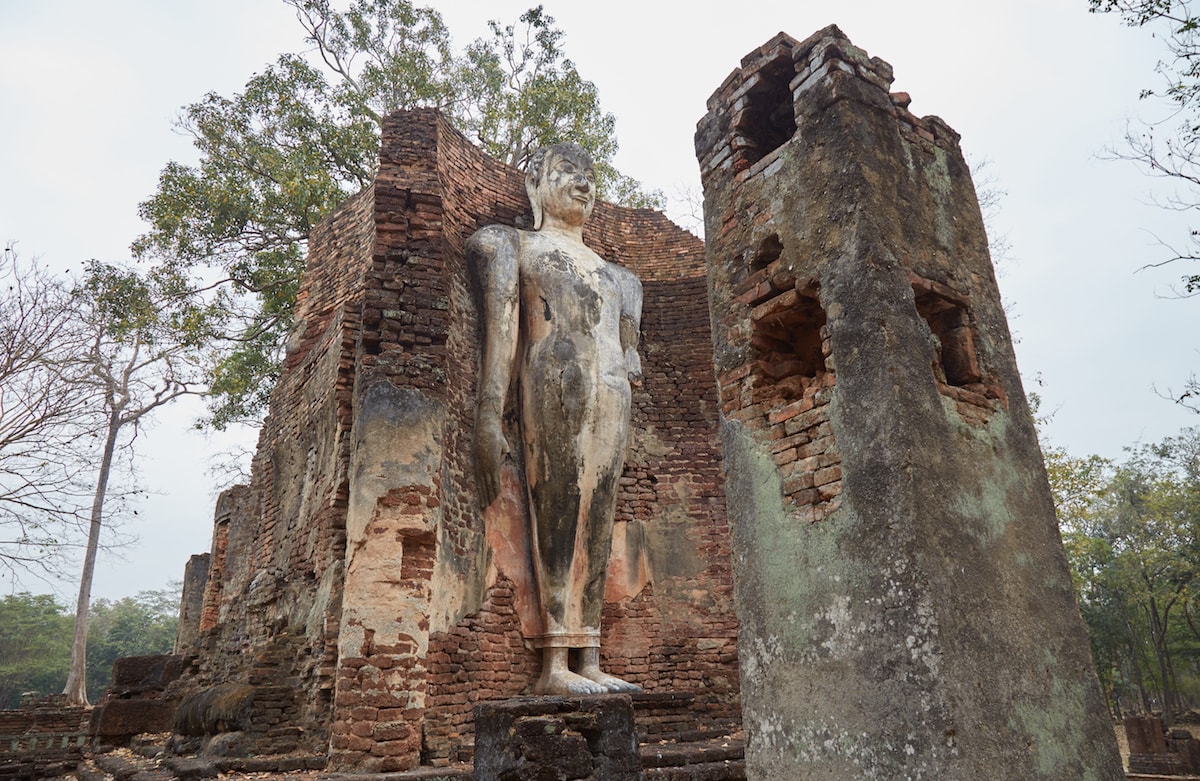
Another notable feature of the temple is the large brick base of what was once the viharn, standing as high as 2 meters. The temple also contained an ubosot, though this was much smaller and not much of it remains today.
Wat Singh
The next major temple you’ll encounter in the forested area is Wat Singh, located just next to Wat Phra Si Ariyabot. And like that temple, Wat Singh also has an elevated laterite base of what was once its viharn. Supposedly, the base was surrounded by lion statues, after which the temple is named. And at one point, the viharn structure was converted into an ubosot, or ordination hall for monks.
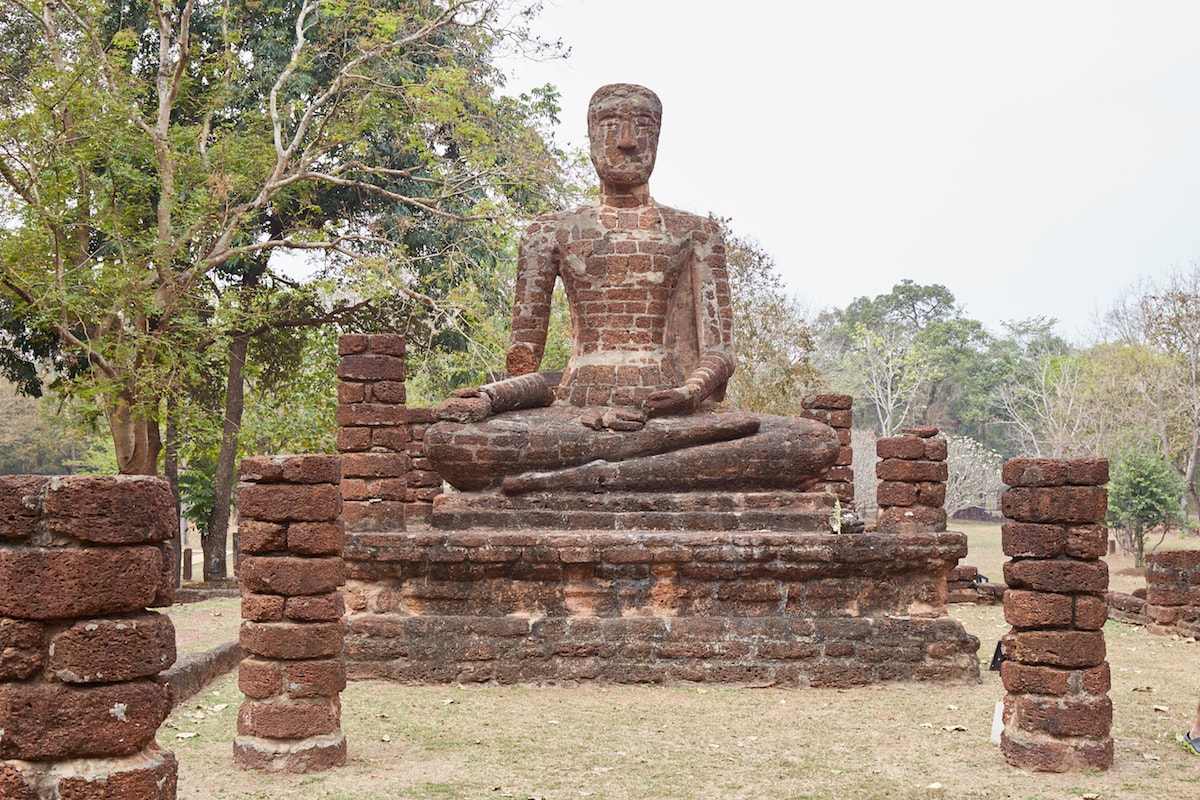
The highlight of this temple as we see it today is its large seated Buddha image. It’s largely survived intact except for one broken arm. Further along, you can also find another seated Buddha image inside of what was the temple’s main chedi
Wat Avasa Yai
Located at the far northern end of the forest zone is the expansive Wat Avasa Yai temple complex. The original layout had the main viharn in the center, with two L-shaped platforms in front and coming around the sides. Behind the viharn was a large chedi, the base of which can still be seen. A series of smaller chedis, meanwhile, adorned the top of the L-shaped platforms.
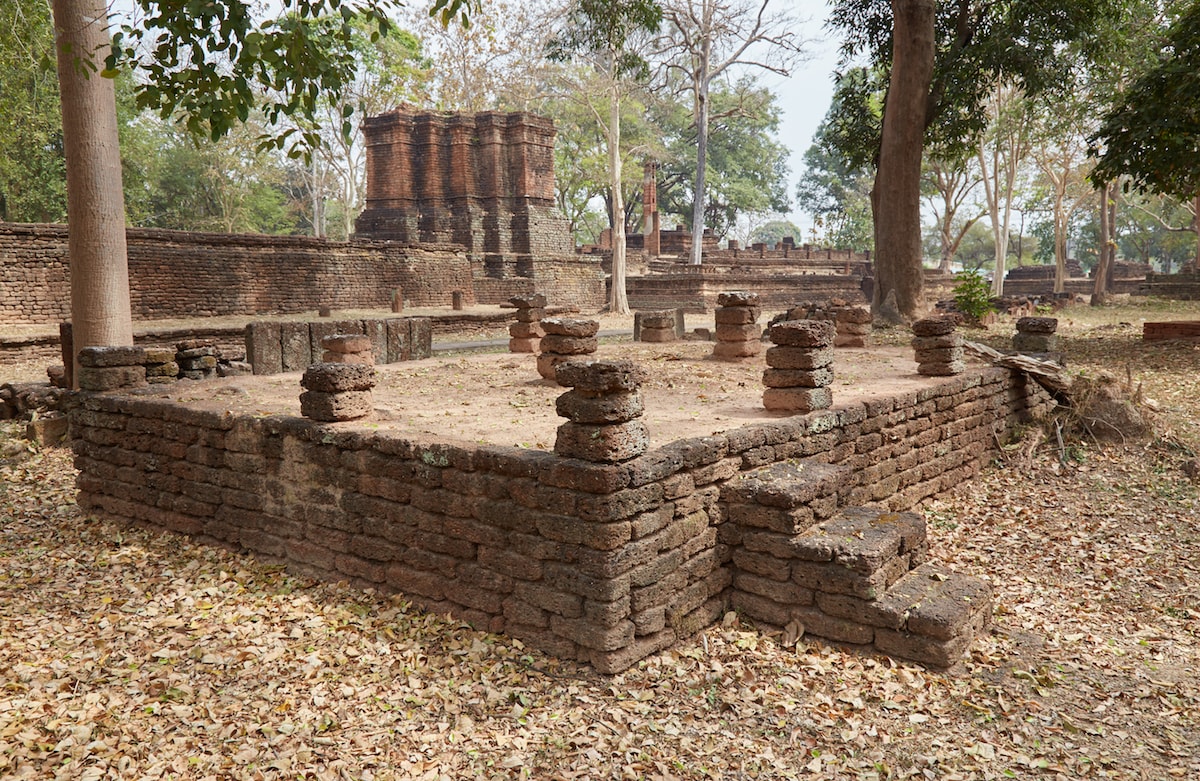
Wat Avasa Yai is one of the more exciting temples to explore in the area, as the platforms and many of the other structures are climbable. One unique feature of this temple is its large pond, though it’s clearly been empty for awhile. Something else which sets Wat Avasa Yai apart from the other temples is its absence of Buddha images or animal figures.
Wat Chang Rob
At the far western, and also highest point of the Aranyik zone, is Wat Chang Rob, one of Kamphaeng Phet’s most stunning temples. This 15th-century temple was named after the dozens of elephants surrounding its massive chedi which was built in the Singhalese, or Sri Lankan, style. The base spans 31 x 31 meters, and while the chedi itself no longer exists, the base remains in good condition and can be climbed to the top.
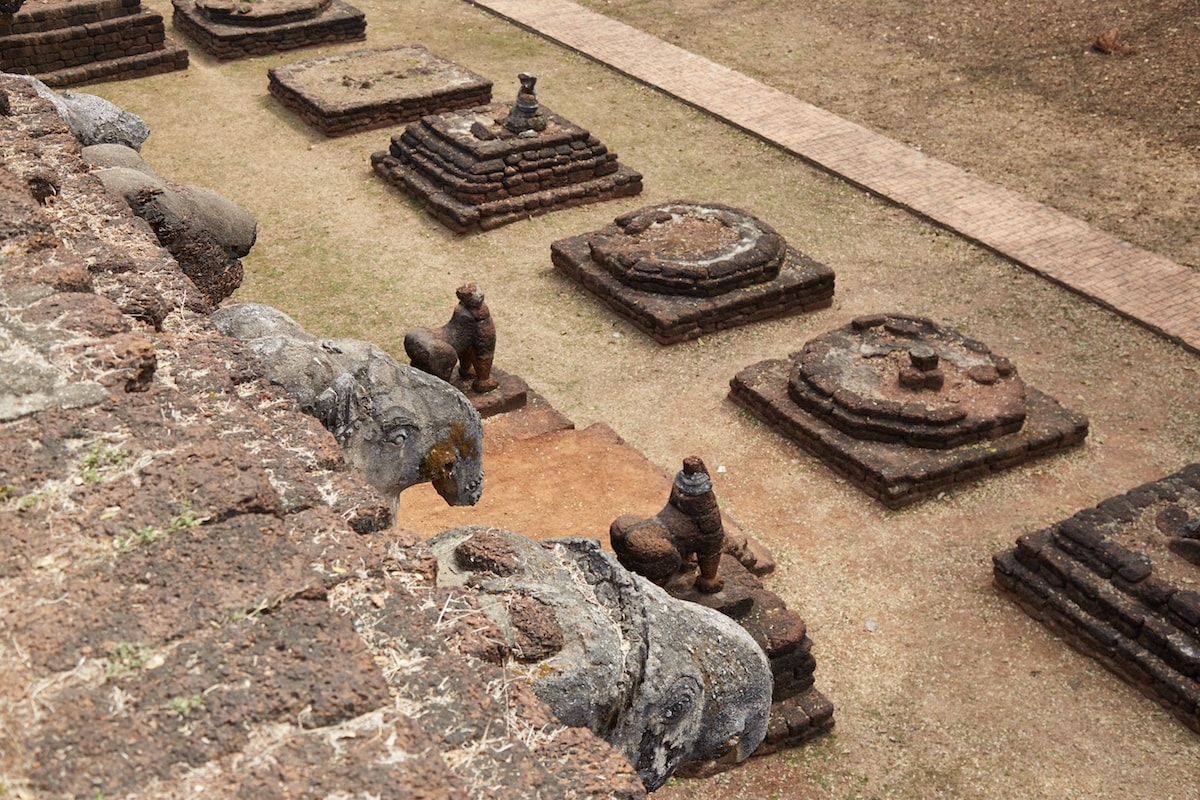
Though influenced by Sri Lanka, elephant-encircled chedis were very popular in Sukhothai. Visiting Sukhothai today, you’ll find that may of these elephants have been recently refurbished and don’t quite fit in with their surroundings. A visit to Wat Chang Rob, then, allows visitors to see animal motifs that have been heavily eroded but otherwise untouched.
While the chedi takes center stage, you can also find the ruins of the viharn, ubosot and a large pond. If you only have time for a few temples in the area, be sure not to miss Wat Chang Rob.
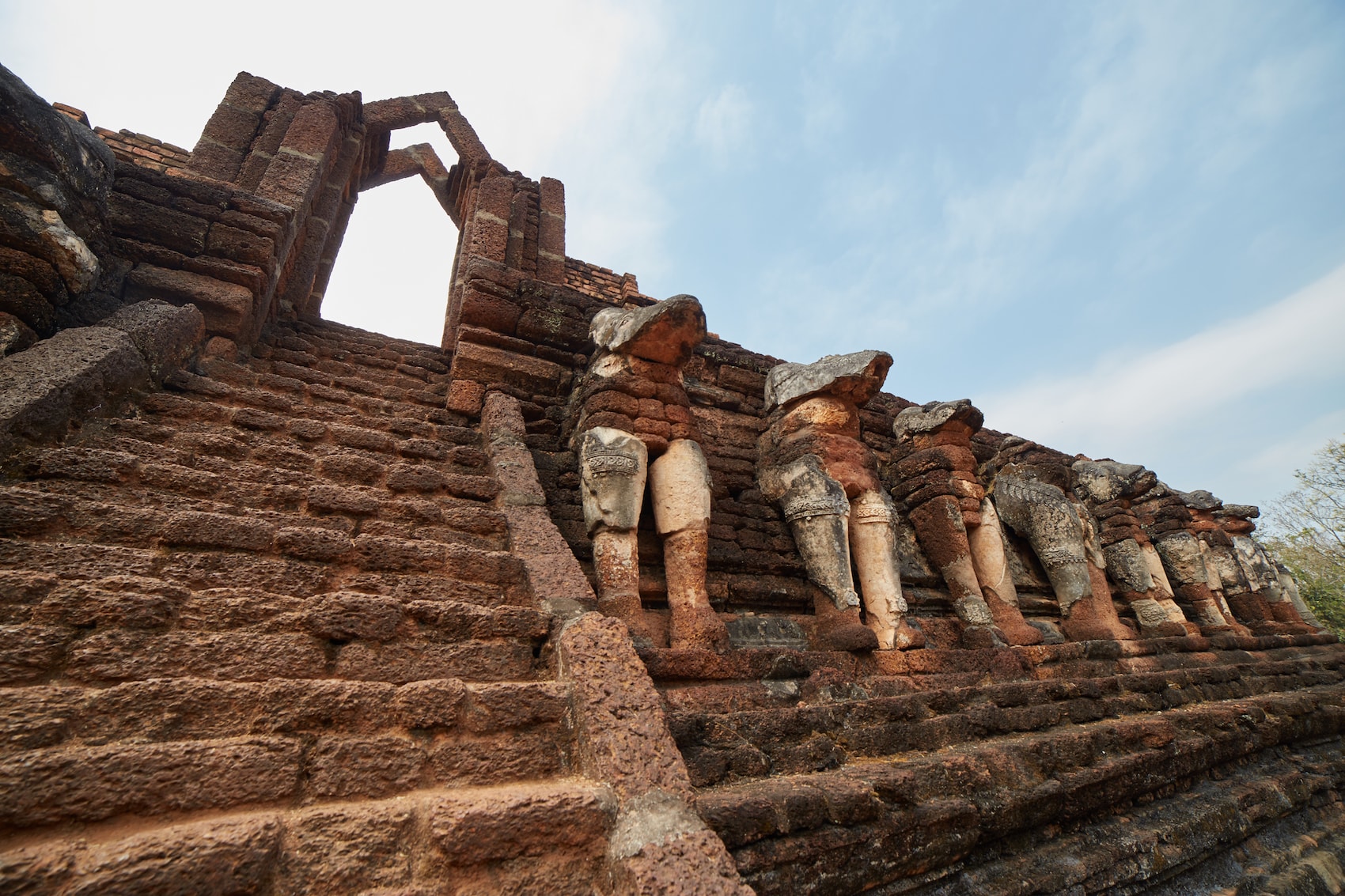
Other Temples
The five temples above are the most impressive, but by no means the only temples there are to see in the Aranyik zone. Below you’ll find a list of almost all the others. While not especially remarkable on their own, it can be fun to bike around the peaceful setting as you try to discover them all.

Wat Kongchai

Wat Kamphaeng Nam

Wat Pekaram
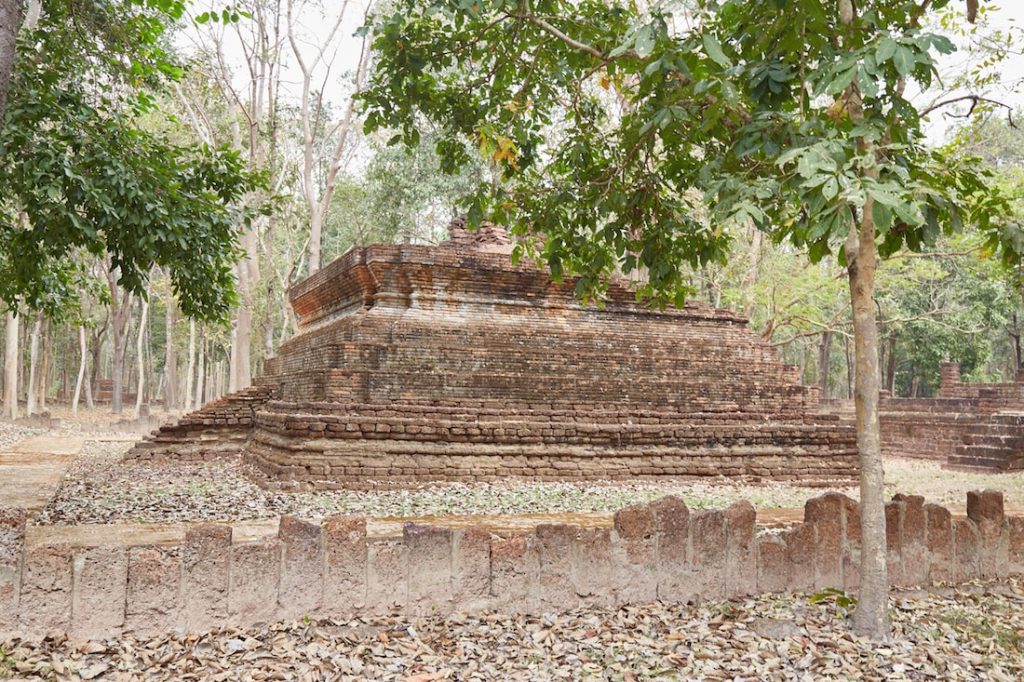
Wat Ma Khet
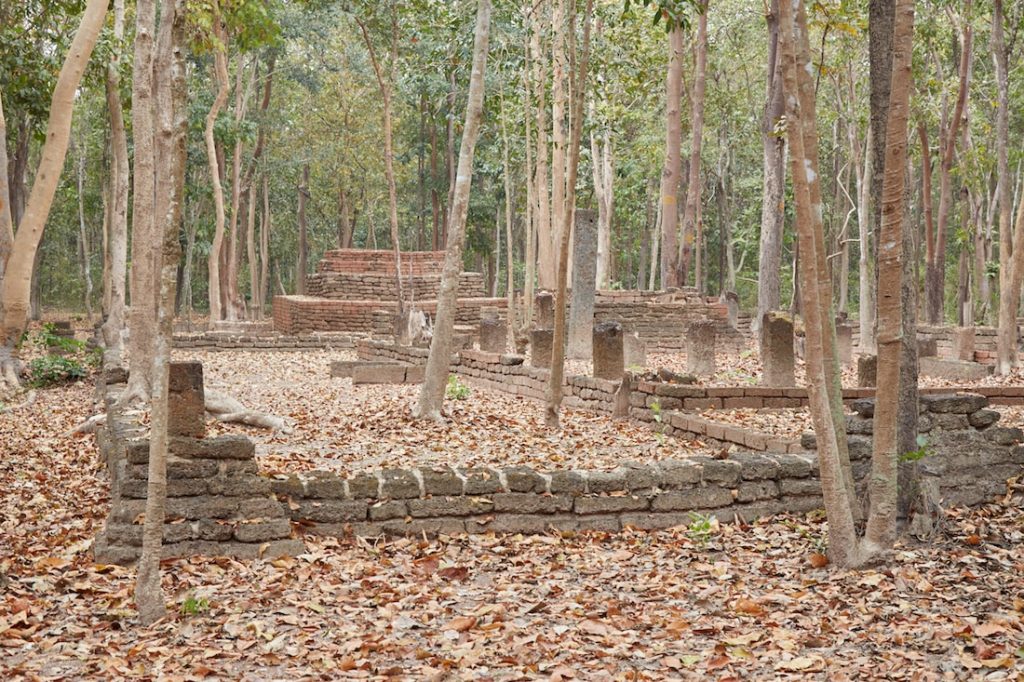
Wat Ma Khok

Wat Rim Tang

Wat Nak Jet Sein

Wat Ramronarong

Wat Ta Baek

Wat Pa Laeng

Wat Ma Phi
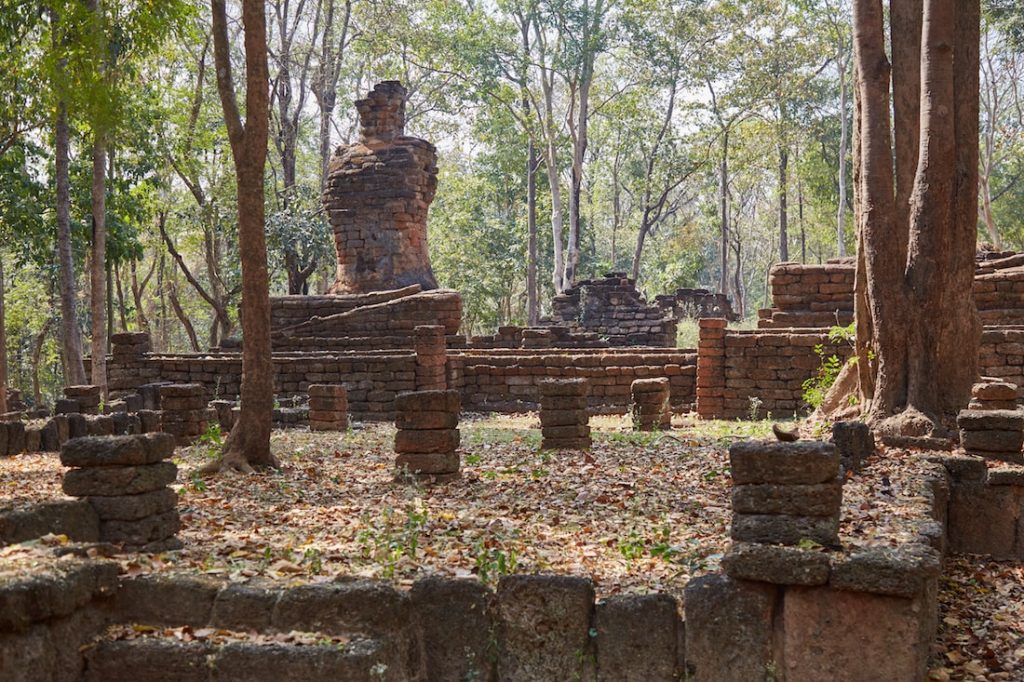
Wat Tao Mor
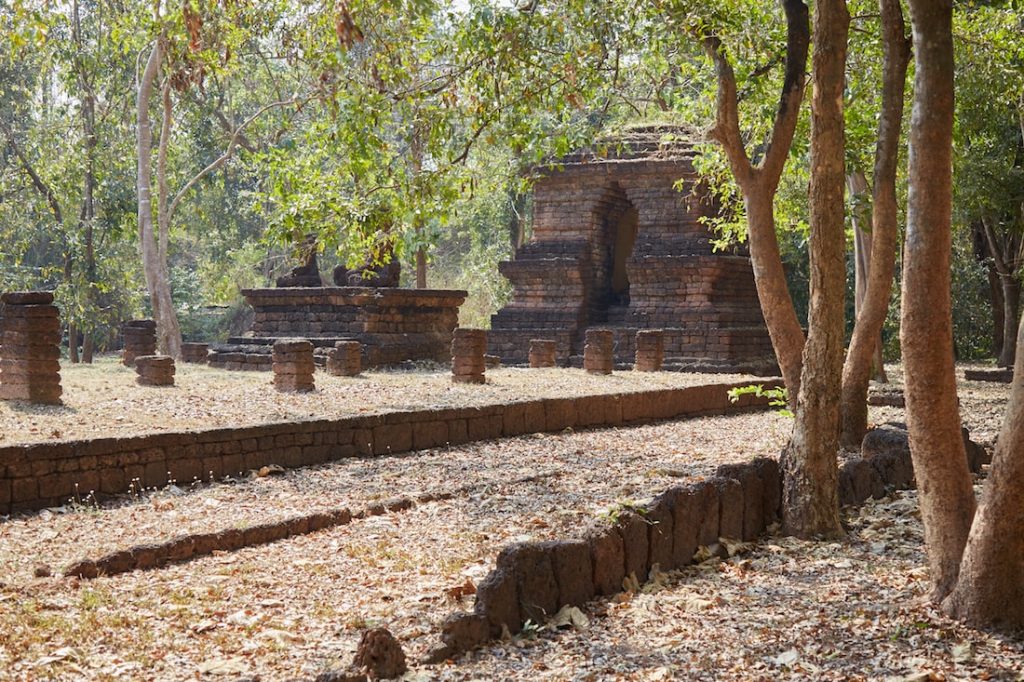
Wat Mondop
Around Town
If you’re looking for a longer stay in Kamphaeng Phet, the general area is also famous for its national parks. Among the most popular are Klong Wang Chao and Klong Lan parks, both known for their waterfalls.
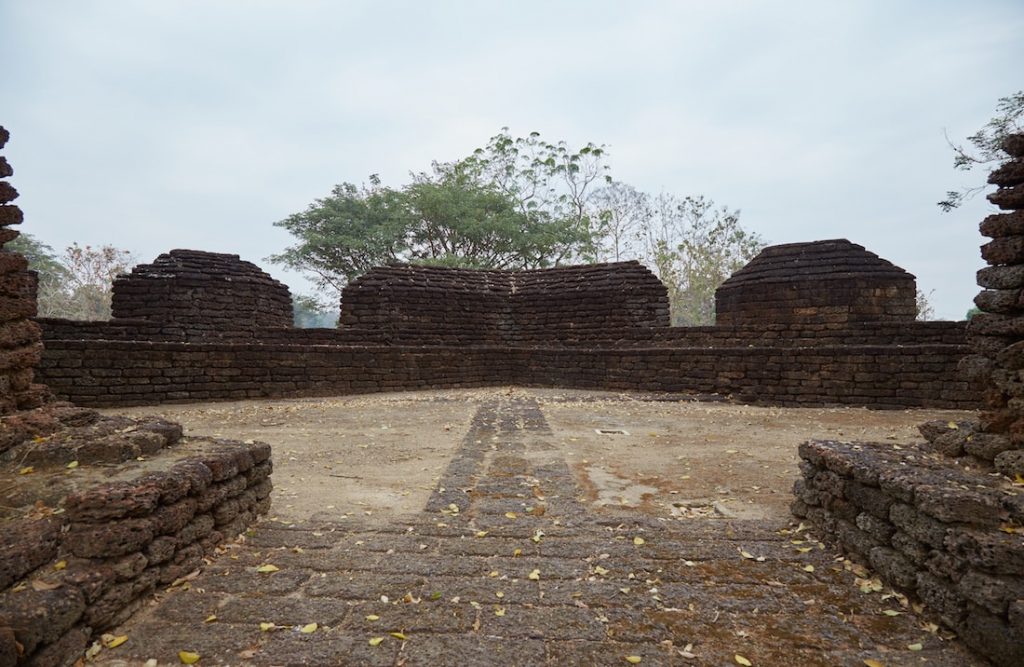

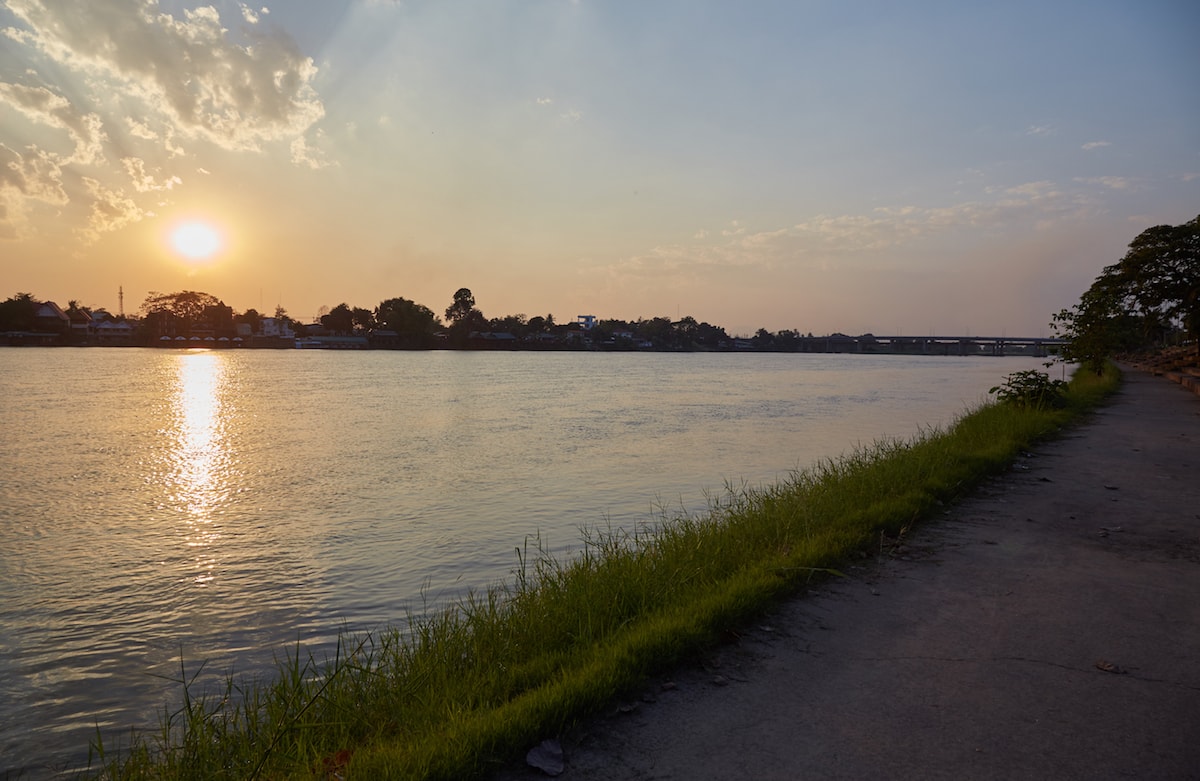
Otherwise, there’s not a whole lot to do or see within the city itself outside the places mentioned above. If you have some free time, though, you can still come across some interesting finds by just riding around on your bicycle. Some impressive city walls, gates, lookout towers and moats are still around and in surprisingly good condition. The Ping River is also a good place to go for a stroll come evening time.
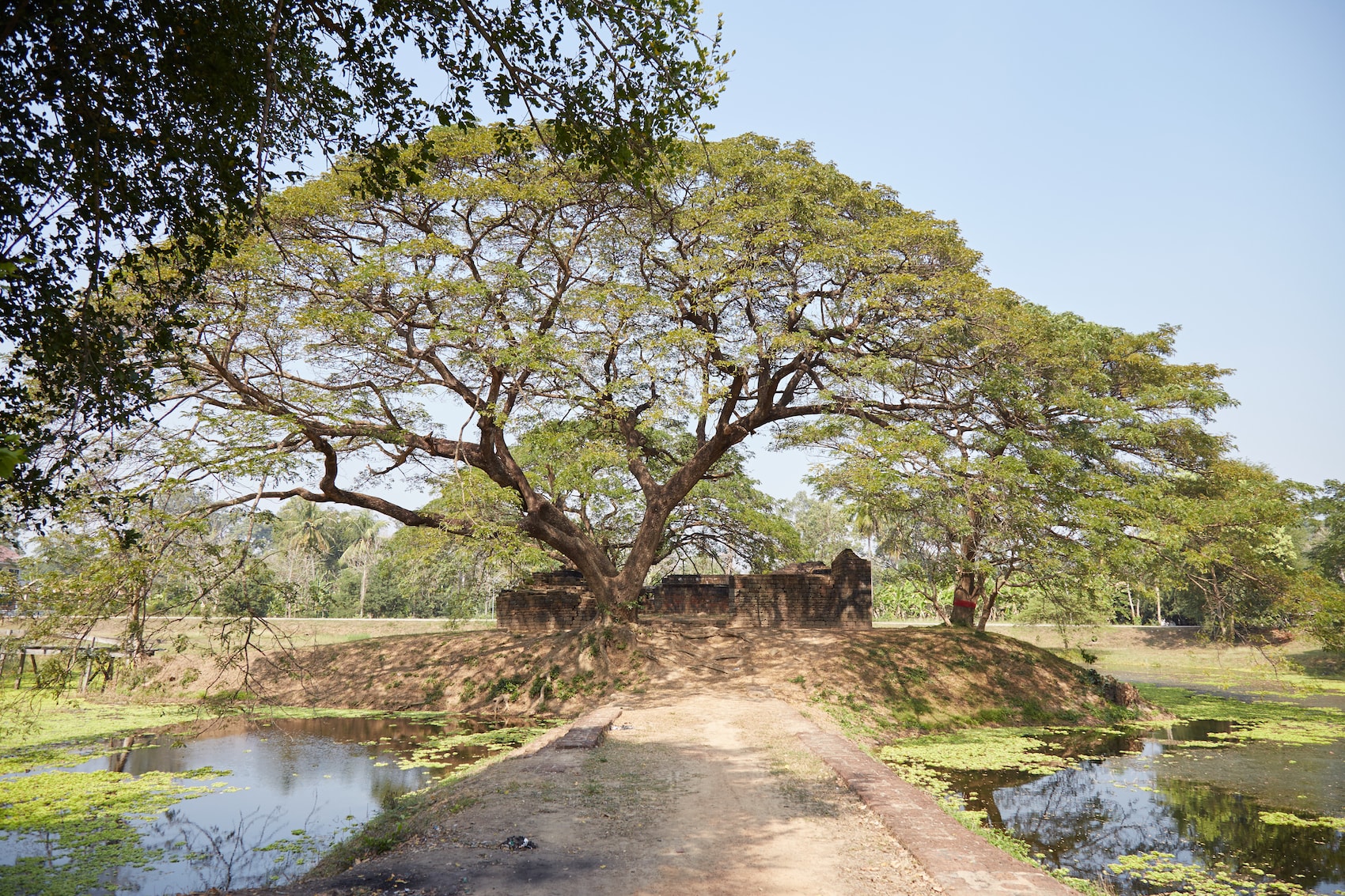
Additional Info
Located along a major highway which connects Chiang Mai to Bangkok, Kamphaeng Phet is accessible from either city by bus. It takes about six hours from either place. When purchasing a ticket in these cities, bear in mind that the bus probably won’t say Kamphaeng Phet on it, and it will merely be a stop along the way. Just tell someone at a ticket counter where you’re going and they’ll tell you which bus to get on.
Many people visit Kamphaeng Phet from Sukhothai, which is just about an hour away. There are regular buses in addition to blue songthaews which leave about every hour. The fee should be around 70 baht.
I did things the other way around, starting in Kamphaeng Phet and going onto Sukhothai from there. At the bus station, I asked about the next bus and they said I’d have to wait for another 2.5 hours! I figured I had no choice. But eventually, I got up to go to the bathroom when a songthaew driver noticed me and asked if I was going to Sukhothai. Luckily, they were leaving right then and there. If the regular bus isn’t leaving for awhile, you’re still likely to find an alternative.
Kamphaeng Phet is nowhere near as popular as neighboring Sukhothai. While that greatly adds to its appeal, it also means that tourist infrastructure is limited. Luckily, there’s a popular English-speaking guest house in town known as Three J Guesthouse.
I stayed in a cozy little private bungalow, which opened up to a spacious shared courtyard full of plants. You can also order breakfast, while a restaurant with an English menu is located right across the street.
If you’re looking for something a little more upscale, you might want to have a look through Booking.com. Just make sure that your hotel is within reasonable distance from the ruins.
Getting around Kamphaeng Phet is best done by bicycle. I was able to walk to the central ruins and back from Three J Guest House. However, the forest ruins would’ve been too far to reasonably walk to, so I decided to rent a bicycle for my second day.
As the forest area is much larger, biking around the ruins is recommended. Walking is not impossible, though, and there were a number of people doing it during my visit. But I’m not sure how they got to the archaeological zone in the first place.
It’s possible to see both the city and the forest zones in a single day. To do so, you’d probably want to skip the National Museum and limit yourself to just the highlights in the forest zone. You can buy a combined entry ticket to visit both zones for 150 baht, which is only valid for the day of purchase.
Bicycle rental is possible at the central ruins, though you may be required to show your passport (not the case in Sukhothai). If you’re staying the night at a hotel, you might just be better off renting a bicycle from there.
If you’re basing yourself for a few days in Sukhothai and are visiting Kamphaeng Phet for a day, you’ll need to negotiate a price with a songthaew or motorbike taxi to at least get you to the central ruins from the bus station. Or, you may want to just go via a day tour through your Sukhothai hotel.
In my case, I spent a few nights in Kamphaeng Phet and toured the ruins and all other sites mentioned in the article over the span of two days. Even taking my time, I was still finished by late afternoon on both days. I enjoyed being able to see everything at a slower pace.
The main downside to the Kamphaeng Phet ruins is the amount of territorial and aggressive dogs all over the forest section. Many of these dogs do not want people coming anywhere near “their” temples, and will bark and bare their teeth as you come close.
In my case, I didn’t have any dogs attempt to attack me, as most of my encounters were with individual dogs who eventually backed off. But this travel vlogger was not so lucky.
Though I didn’t have any encounters with a large group, I counted nearly a dozen dogs sleeping near the entrance and within clear view of the ticket checkers. Furthermore, the sound of howling, barking and fighting dogs is a near constant throughout the forest area. Would all of these dogs be living in this uninhabited forest if no humans were regularly feeding them?
Regardless of who’s taking care of them, there’s no doubt that the authorities are aware of these dogs’ presence and at the time of writing, no action is being taken. Shame on the local authorities for putting the comfort of stray dogs over the wellbeing and safety of human visitors to the ruins. This is a major problem in Ayutthaya as well, though not in Sukhothai, as far as I could tell.
It doesn’t matter how much of a dog lover you may be – rabies is a real issue in Thailand. And if you get bit by a dog (or cat), you can’t really expect the animal owner or property manager to chip in and pay for your medical costs. To make matters worse, simply defending yourself from an animal attack can get you in trouble with authorities for “animal cruelty.”
So what can you do? A couple of minor solutions include bringing a compact umbrella with you, even on a sunny day. Supposedly, some dogs get frightened when they see an umbrella opening up. I’d also recommend buying an ultrasonic dog repellent device before your trip, such as this one. There’s no telling, though, if this would be of any use when fending off an entire dog pack.
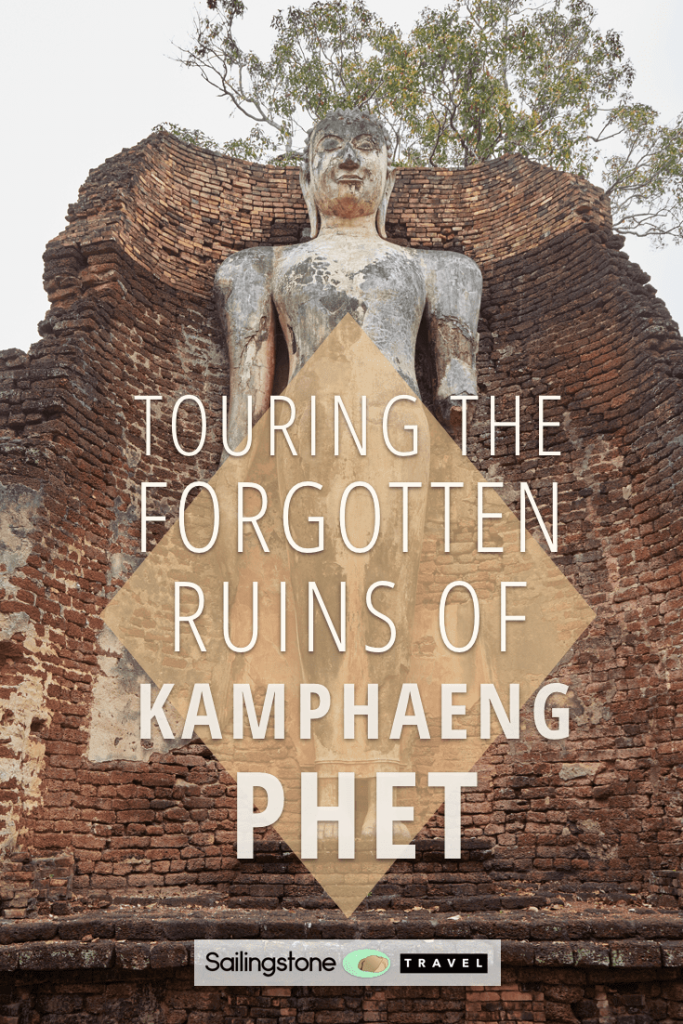
Pin It!


